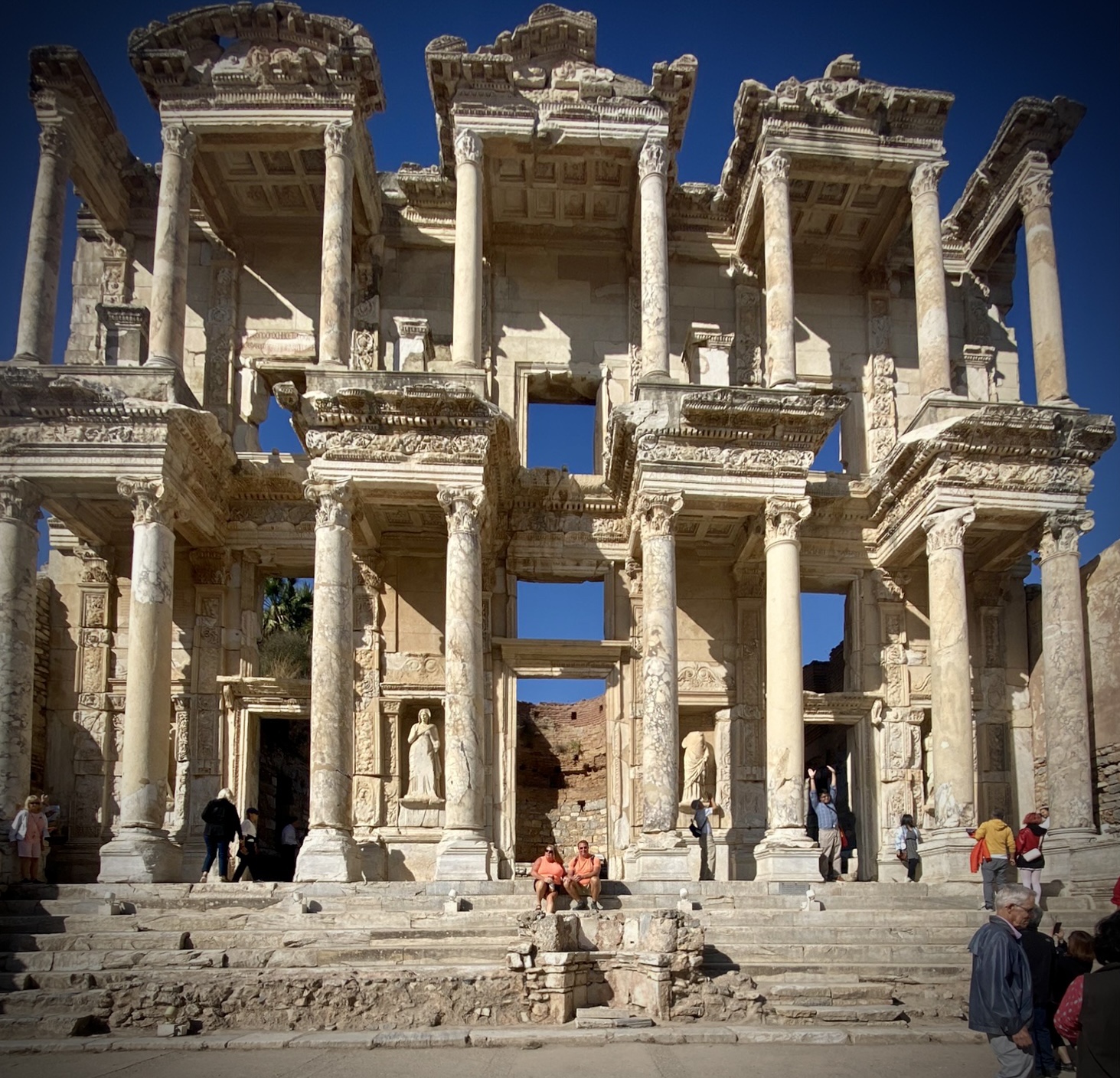In October/November 2022, we went on two back-to-back cruises around the Mediterranean, spending a total of 24 nights on the two ships. These are all of the ports we visited outside of Italy, of which there were many! The Mediterranean shores cover a number of countries, and these cruises did as well.
Click here to read our review of the two ships, and click here to read about the Italian ports.
Perast (via Kotor), Montenegro
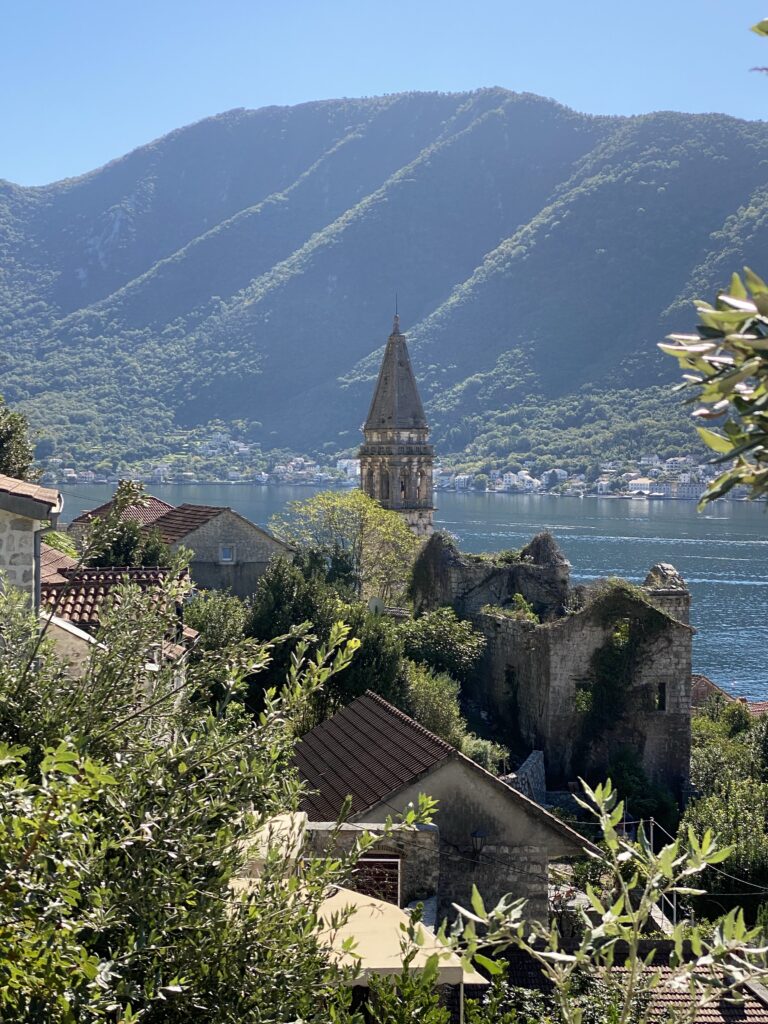
This was the second time we visited Kotor as a cruise stop. The first time we stayed in town and walked around the old city walls. So this time we decided to do something different, so we made a small day trip to a nearby town, Perast. Perast is also a coastal town on the Bay of Kotor, and can be seen from cruise ships on the sail into Kotor. We had read that it was scenic and worth a visit.
The local bus to Perast is referred to as the “blue line.” We had issues finding the bus stop and by the time we figured it out, we watched one of the buses drive by. Finding another couple with a similar issue, we decided to share a taxi, for €10 each couple. The drive was about 20 minutes on a moderately-scenic coastal road.
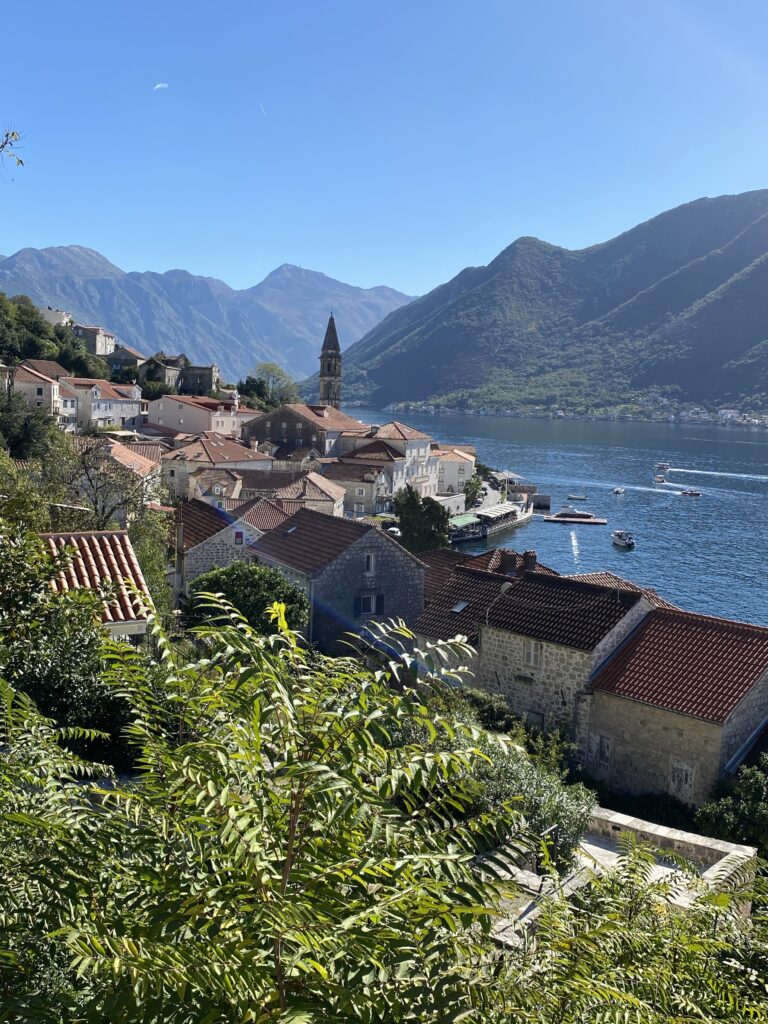
As we exited the cab, we were swarmed by touts for boat tours. Many folks, including the other couple in the cab, come to Perast to take a boat tour to the island church and around the harbor. We chose to pass on this since the cruise ship passes by these islands on its way in and out of the harbor.
Perast is a very small village set into a hillside. When the main road goes through Perast, it passes on the hillside above the town. There is also a smaller road along the water. The town is fundamentally comprised of these two roads and a maze of steep stairs that connect the two roads. We spent some time walking these stairs and enjoying the views of the bay and the islands. Without these detours, though, the town can be walked in under 20 minutes.
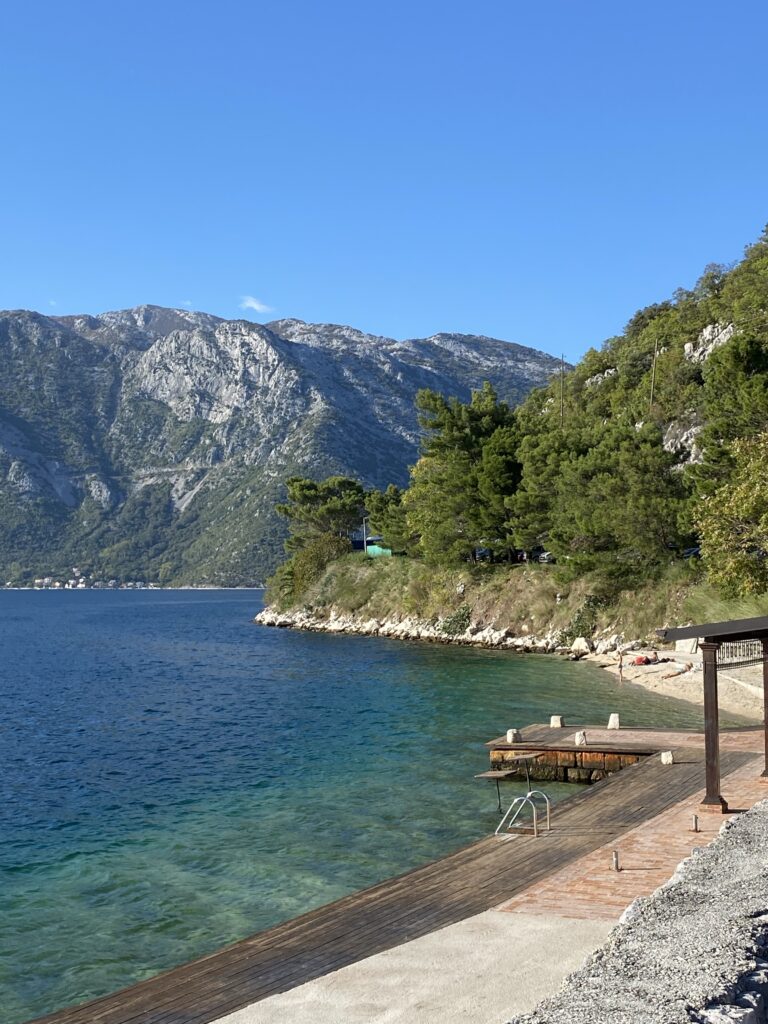
Due to its history, the town has Venetian architectural elements, including a collection of old homes charitably referred to as palazzi (palaces). We enjoyed the churches on the hillsides, including a large bell tower and a church dating to the 9th Century.
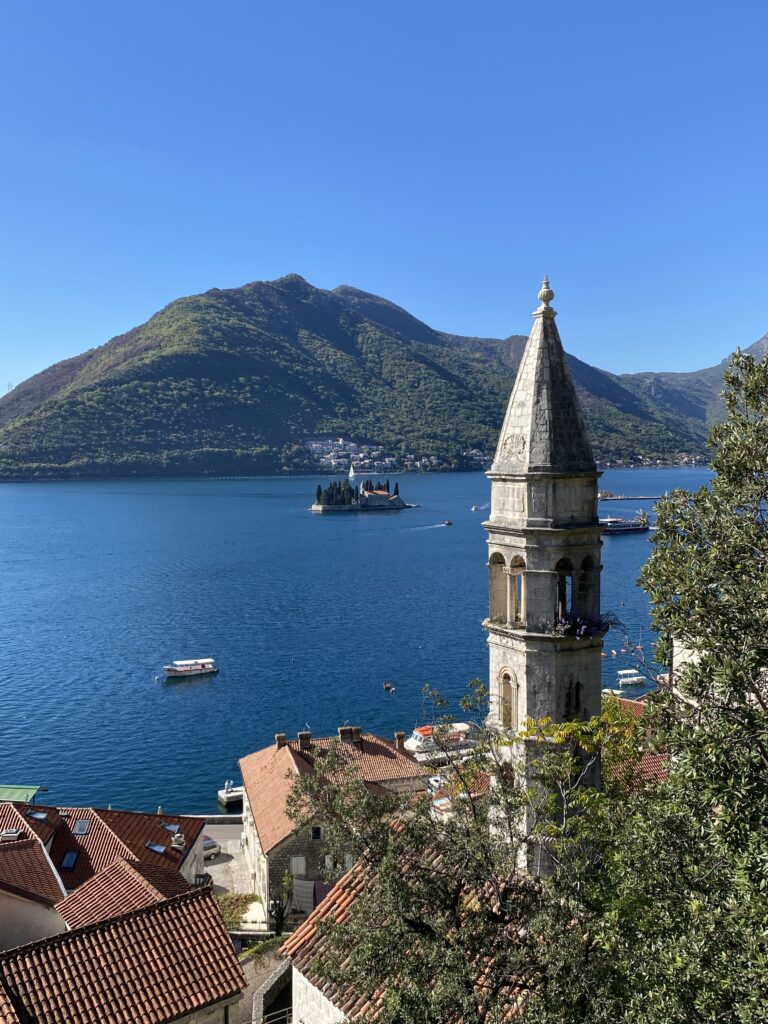
On the coastal road, we paid to enter St. Nicholas Church, an ancient Catholic church that has never been finished. This was interesting but paled in comparison to what we saw in small towns in Italy. We recommend skipping the entrance fee and just enjoying it from the exterior. Since it was October, the bell tower climb was already closed for the season.
We enjoyed a guided tour through the Perast Museum, aka the Perast Maritime Museum. This is a chance to learn the town history and also see a well-maintained palazzo home. This was worthwhile and helped put the Venetian influence in context. We had read that the balcony offered views worth the price of admission, but the balcony was closed during our visit. If this is important to you, check at the desk before paying. The guided tour of the museum was less than an hour. Like most guided tours, it added a lot of context, but at the expense of rushing the museum experience.
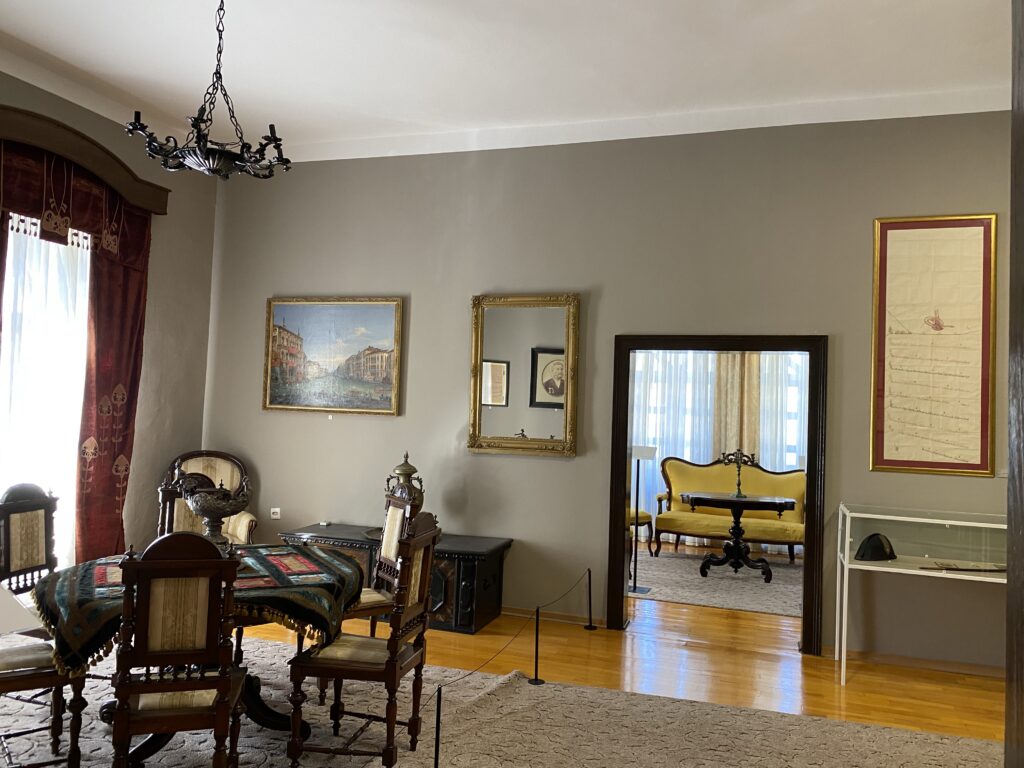
The coastal road has a gauntlet of tourist-focused seafood restaurants, which seemed expensive and forgettable. On the north side of the town is a small swimming beach with a pirate-themed beach bar. The beach bar was closed for the season, but looked like it could be a fun scene in the summertime.
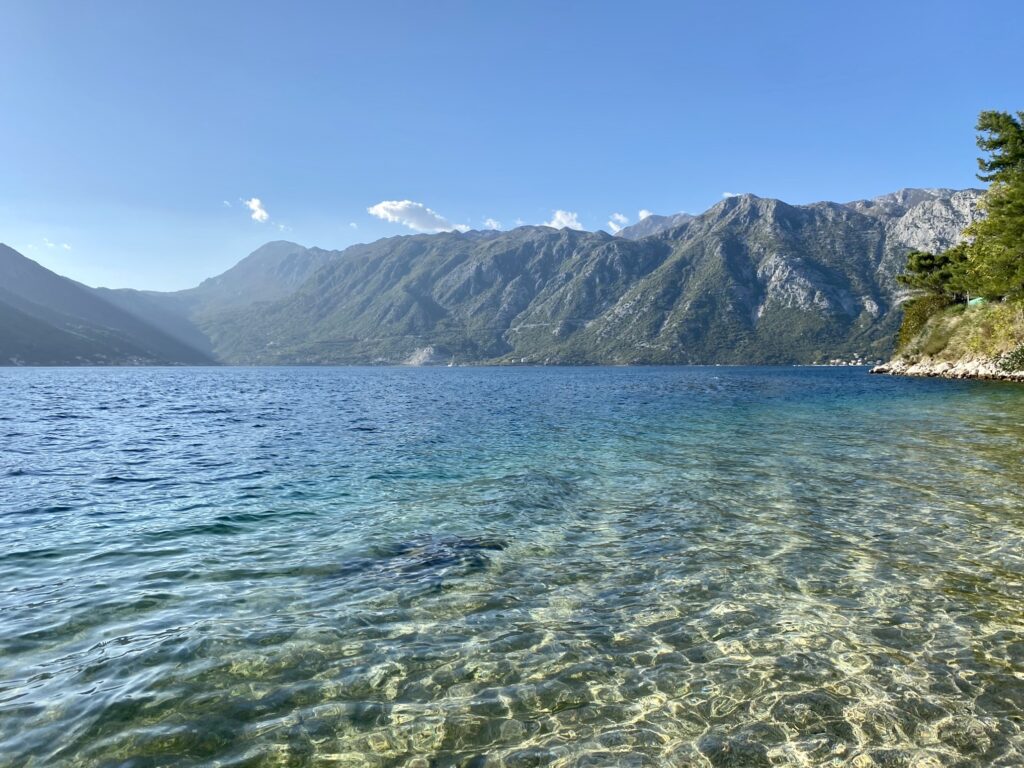
As we were walking toward the blue line bus stop, our taxi driver from the morning drove by us and offered us a ride back to town, again for €10.
Overall we found Perast to be pretty but not exceptional. Because of the proximity to the road, it is on many tour group itineraries and cruise ship shore excursions, and it sounds like it is swamped with tourists in summertime. Kotor is an amazing cruise port, especially because of the scenery coming in and out of the bay, and next time we would choose another destination to further enjoy the bay.
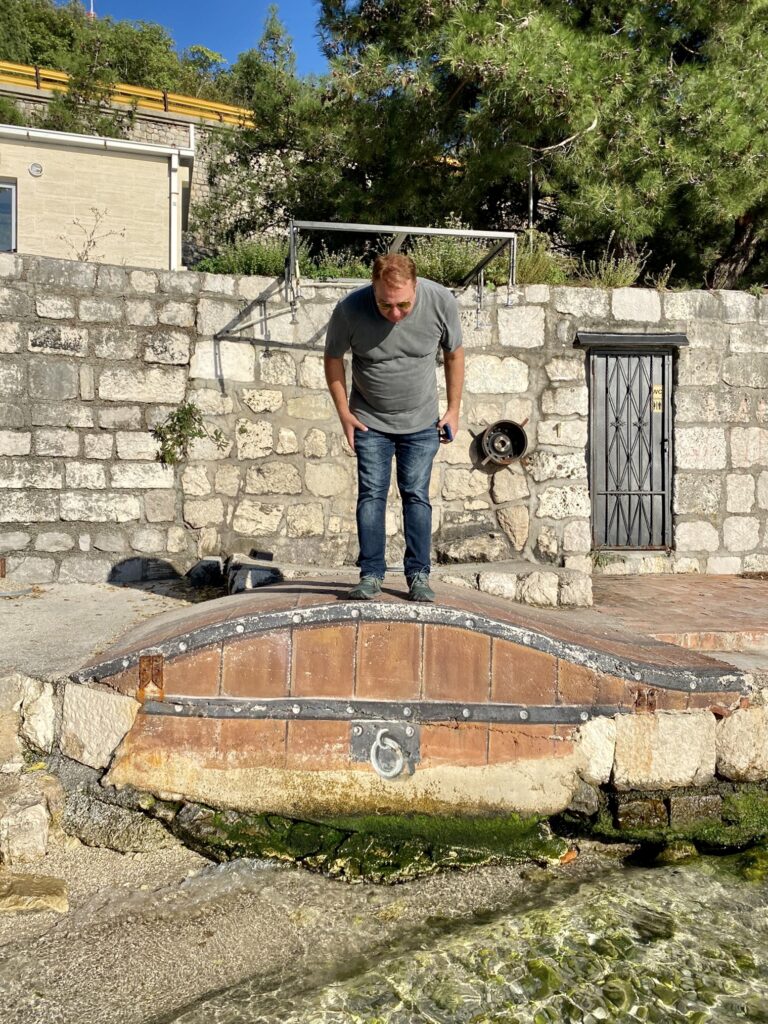
Athens (via Piraeus), Greece
With this being my first trip to Athens, we wanted to focus on the major historic sites. We had read that the Athens metro system reaches the cruise port, and so we expected that transit would be fairly easy. But Piraeus is a huge port! Where our ship docked was about a 30 minute walk from the actual metro station. In hindsight, we should have switched strategies to taking a bus. We do not mind walking but wanted to get to the sites as soon as possible. Between the ship and the bus stop were bus ticket vending machines and informational kiosks. If Piraeus is your port, figure out where your ship is and then use whatever transit method is closest to your ship! [Update for 2025: Athens transit now accepts credit cards for tap-on/tap-off. Use Google Maps or Moovit to find the best transit route (bus or metro) and don’t worry about tickets.]
The first destination was to visit the Acropolis to climb the hill and view the Parthenon. We prioritized food and first stopped for baked goods! The size was extraordinary but the taste was not.
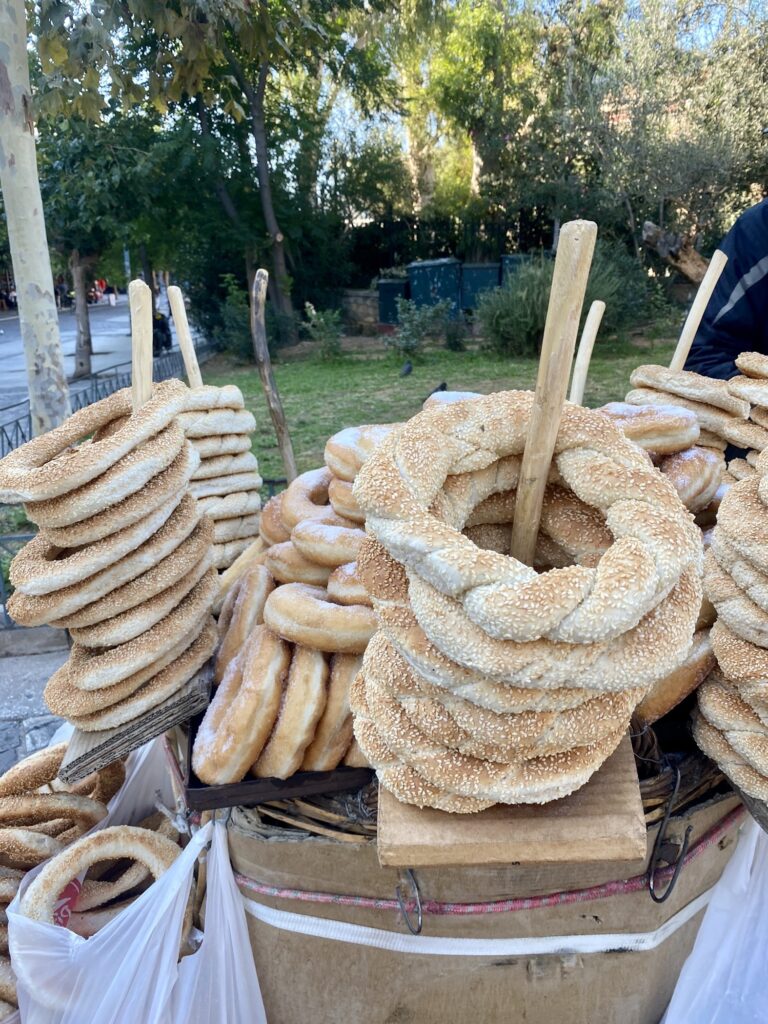
The Historic Sites ticket vending machines were very clear. We bought a €30 pass that allowed us to get into a set of ancient sites, all printed on the ticket. Less-expensive tickets are available that only enter the Acropolis. [Update for 2025: The combination ticket is no longer available, and Acropolis entries are now timed. Get details and tickets at https://hhticket.gr/, but you will now have to choose which sites to enter a la carte.]
We entered the Acropolis grounds and started climbing the hill. The south slope of the hill was closed for renovation work, so we may have missed some of the sites. There is a combination of mostly-gone ruins (signs in front of a few rocks indicating the history of the site) and some well-intact areas.

Throughout the walk, there are great views of the sprawling city, as well as different angles of the Parthenon.
The Parthenon complex itself was a little underwhelming. What is left is extraordinary to see, for certain! We tried to follow a walking tour but many of the highlights were things like the former location of statues. And the hilltop was extremely crowded with an obstacle course of tourists lining up selfies.
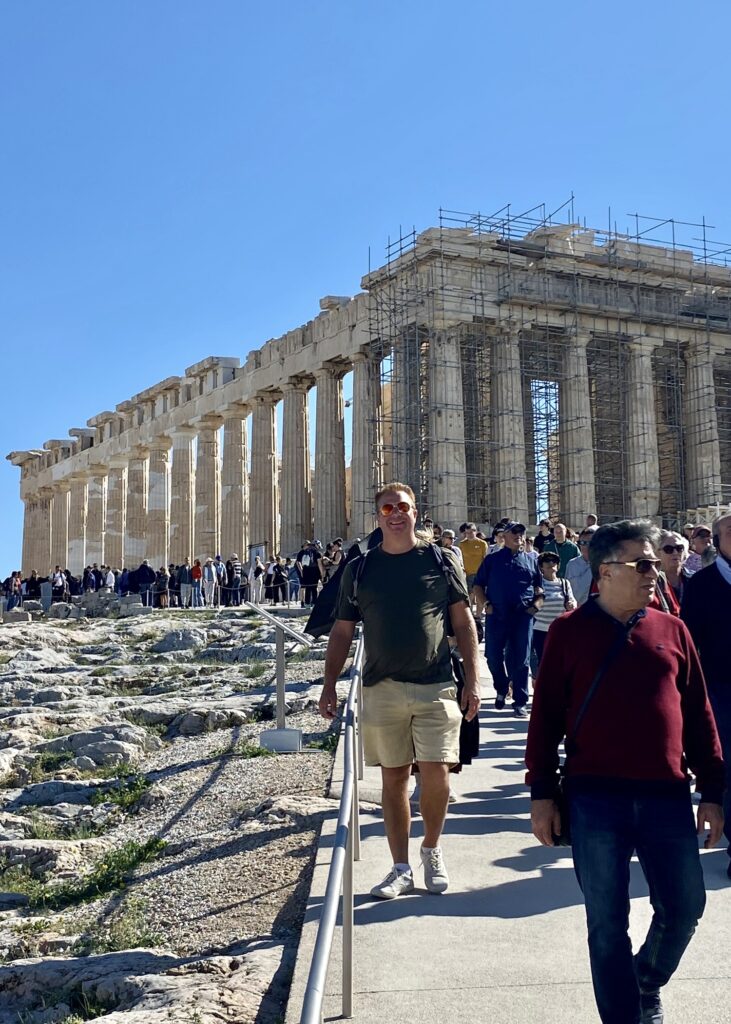
It is absolutely worth walking to the top and taking a walk through what remains, but I think there are better education opportunities via museums. Both the Acropolis Museum and the National Archaeological Museum are well-reviewed. Having seen the area in person on a lovely sunny day, next time I would stay indoors and focus on learning.
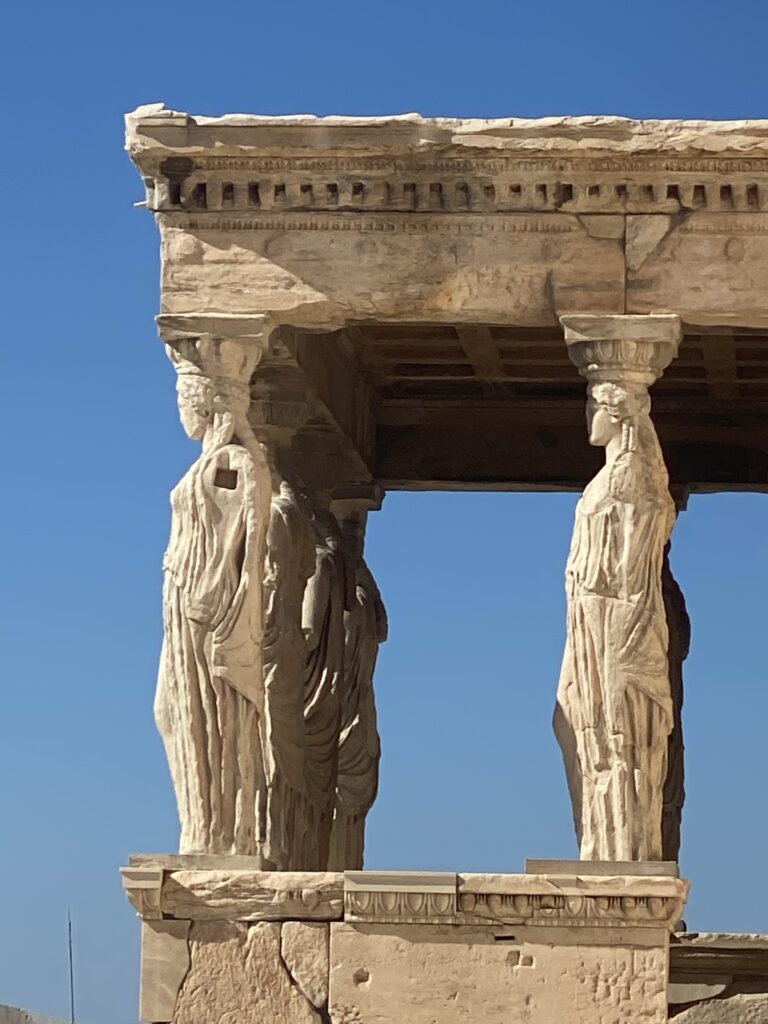
After climbing down the hill, we spent the rest of the day going through the other sites. Planning a walking route for this is interesting because each site can be known by various names. Google Maps will generally locate the site with whatever name you type, and none of the sites are that far from each other. We went through both Agora sites (Ancient and Roman), Hadrian’s Library, the Kerameikos site, and the Temple of Olympian Zeus (aka the Olympieion). We skipped Aristotle’s School (aka the Lykeion) because it seemed the least-important.
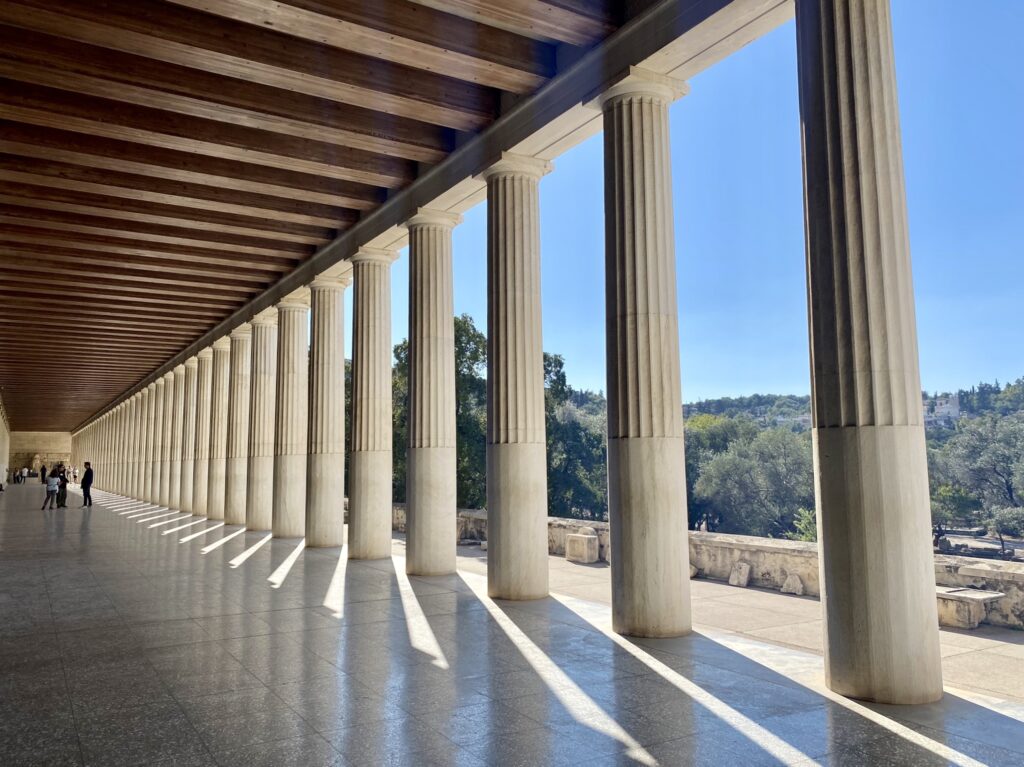
Many of these sites can be seen from outside the fencing, and indeed, we saw a number of walking tours that stood outside, gave short lectures on the sites, and then moved onward. For us, it was better to give the money to the agencies that are providing upkeep and conservation of the sites, although we likely missed some of the context of what we were looking at. If you are taking a tour, double-check whether it includes site admissions.
We enjoyed Greek lunch in the city and took a bus back to the ship which worked out well for us.
This was a great use of a port visit, and while Athens did not seem like a beautiful city (sprawling and polluted), we would come back to view more ancient sculpture and art, and continue to learn about the ancient Greek civilization.
Olympia (via Katakolon), Greece
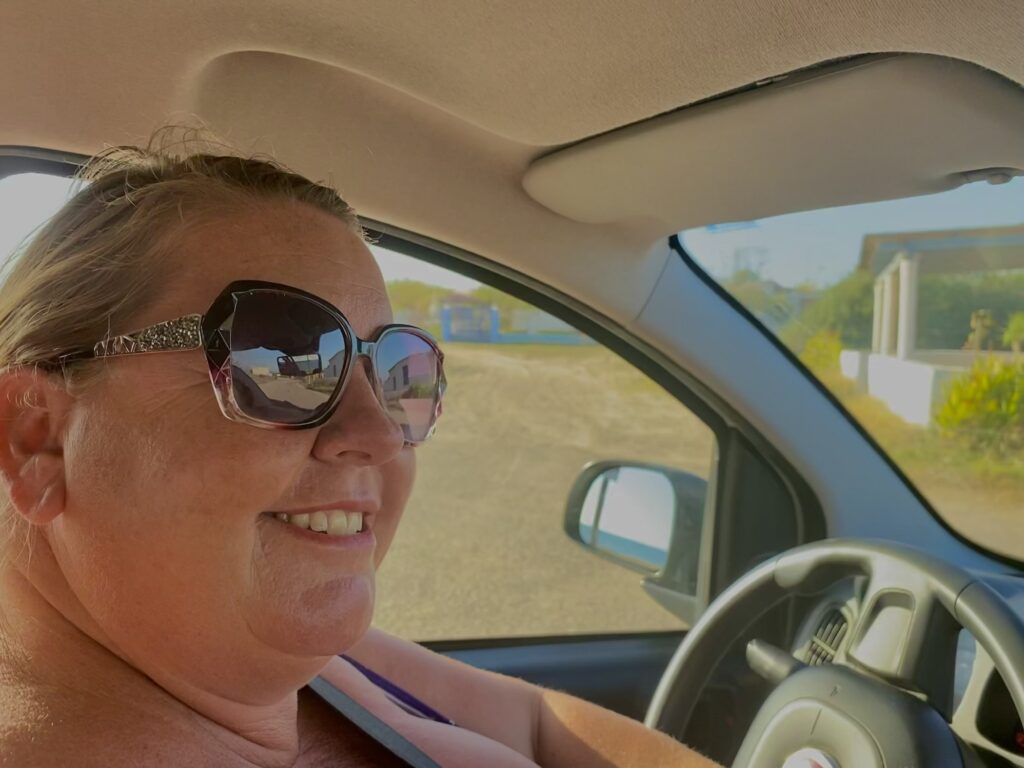
Our plan for the day was simple: Get to the Olympia ruins and spend the day there. Just outside of the port are a few different shuttle services, but we were attracted to a podium touting rental cars. When we did the math, the price for the car was pretty similar to the price for two shuttle tickets. And a rental car provides us the opportunity to go on our timeline, and not be stuck on a bus with dozens of other cruise passengers. Typical for Europe, the car was a tiny stick-shift. Tammy had a moment in the parking lot as she reacquainted herself with manual transmissions, made more difficult with the rental car agent staring at us.
Olympia town is a series of narrow one-way streets. We were looking for the Olympia site’s parking lot for passenger vehicles, but it was difficult to find due to the plethora of tour buses that were double-parked, blocking the city streets and the parking lot entrances. Luckily we were able to find street parking right outside, and walked into the site.
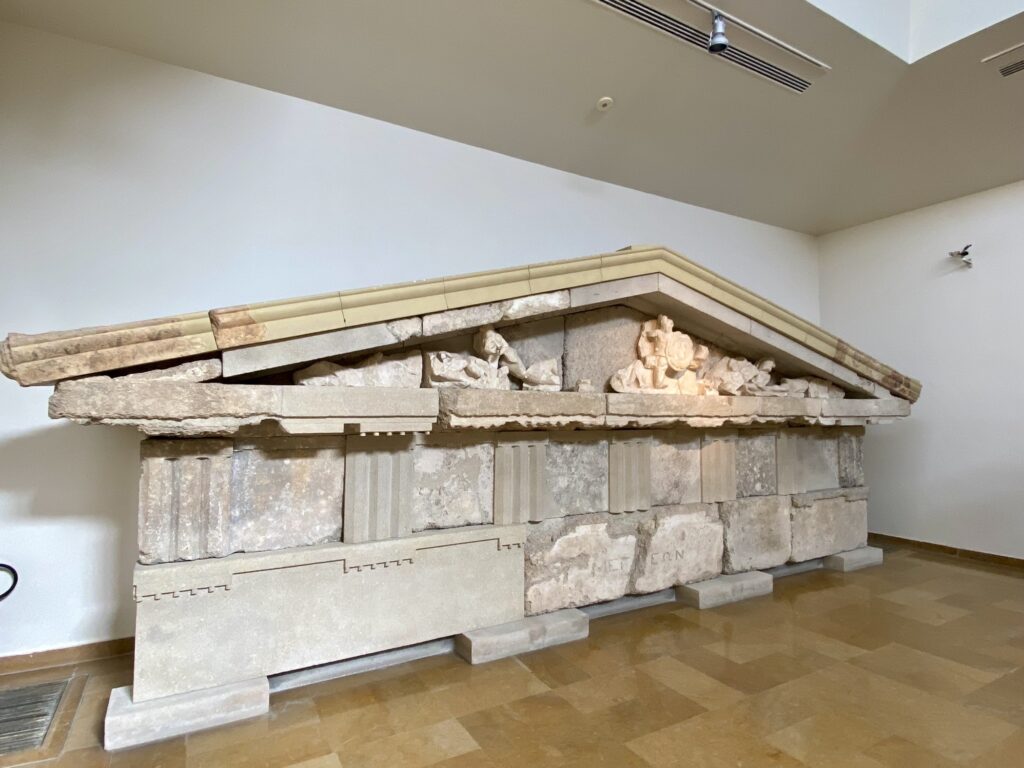
The €6 ticket includes the site itself, as well as two museums, one dedicated to the site and one dedicated to the ancient Olympic Games. The experience is well worth it. There are so many ruins to explore and work is still ongoing to uncover the structures.
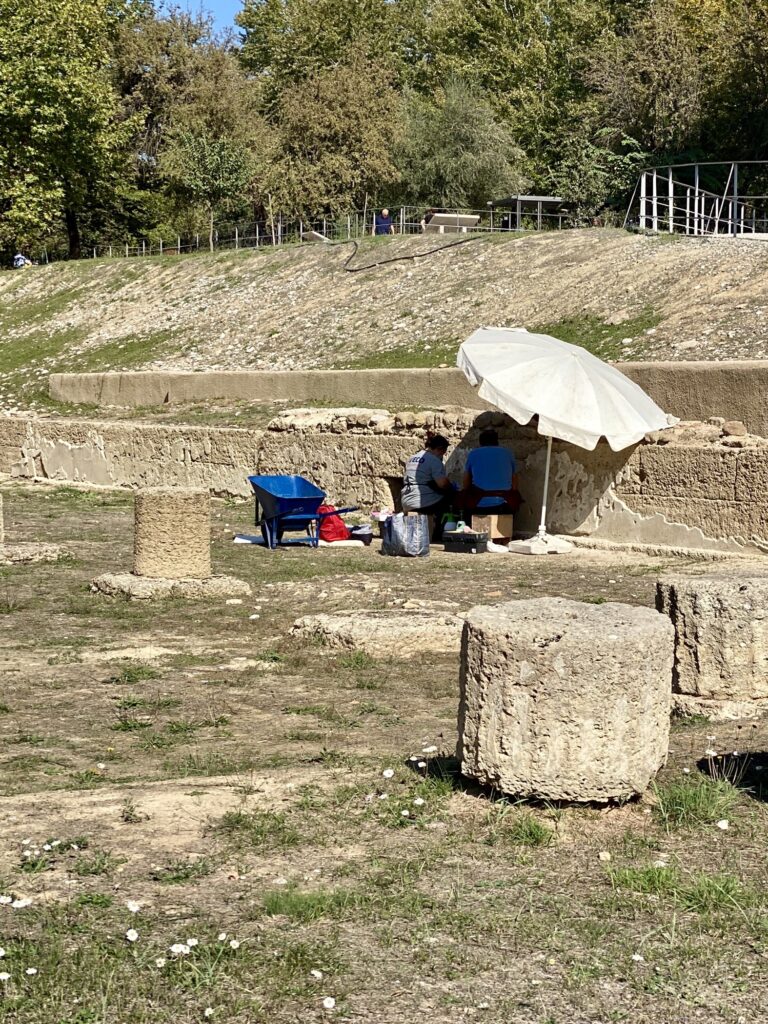
It can be challenging to understand the ruins so a tour guide or book is recommended so you can understand what you’re looking at.
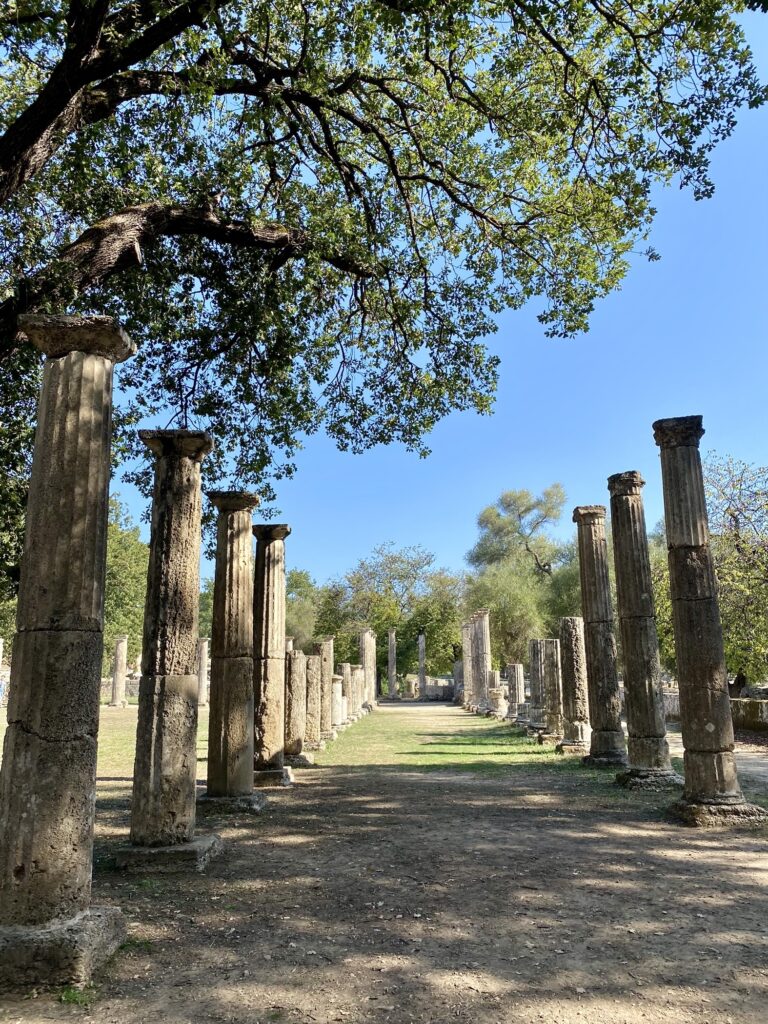
One of the highlights is being able to walk through the tunnel at the original Olympic Stadium and take a run on the 700-foot track. Here is a video of me making that run!
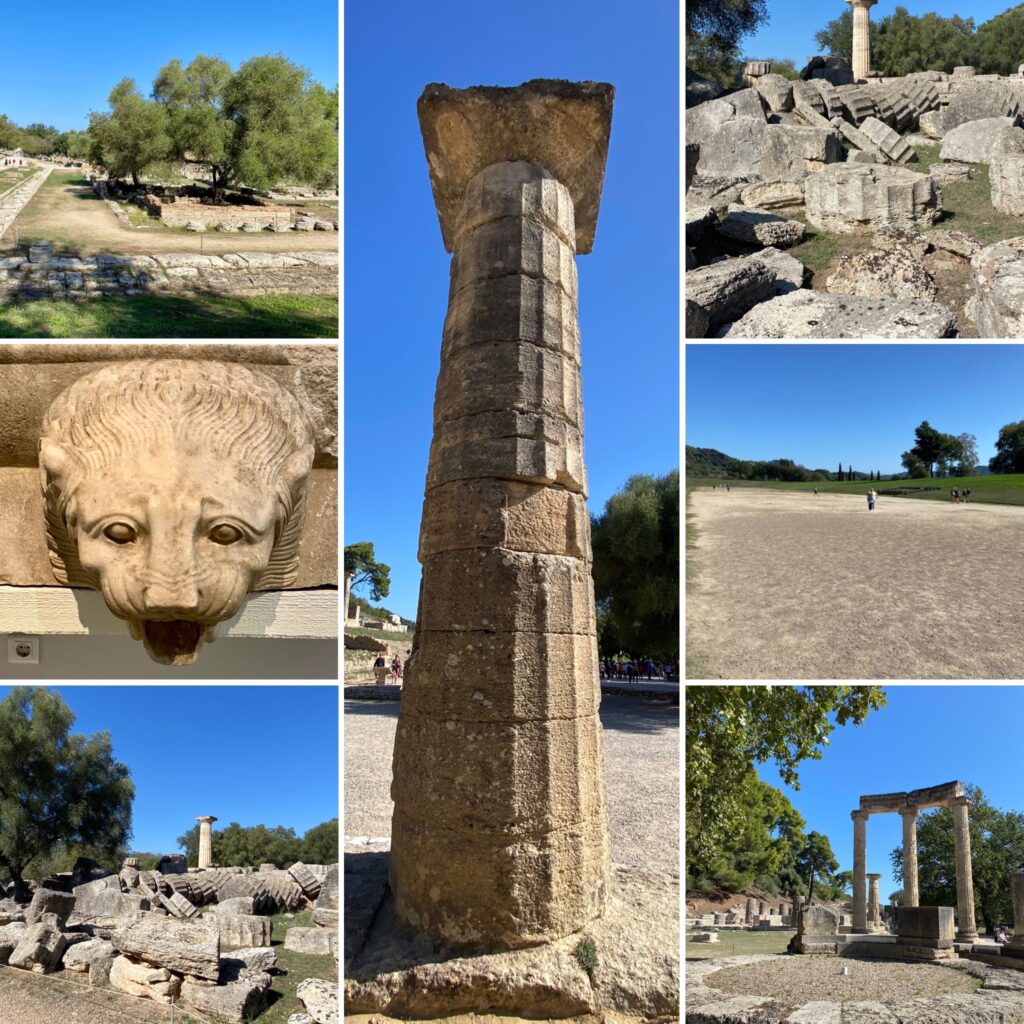
Another advantage of a rental car: We had the time and the ability to make a detour on the way back to the port.
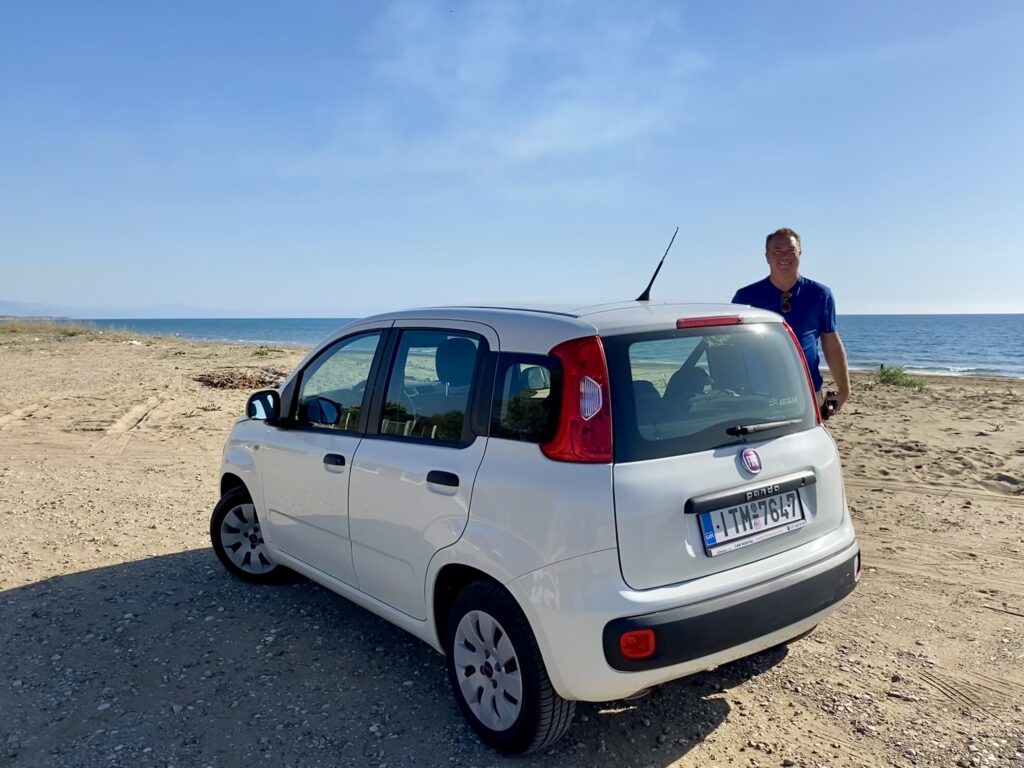
We found a sandy beach that was completely empty, and spent an hour or so catching some sun rays. Then back in the car for a seamless return to the ship!
Mykonos, Greece
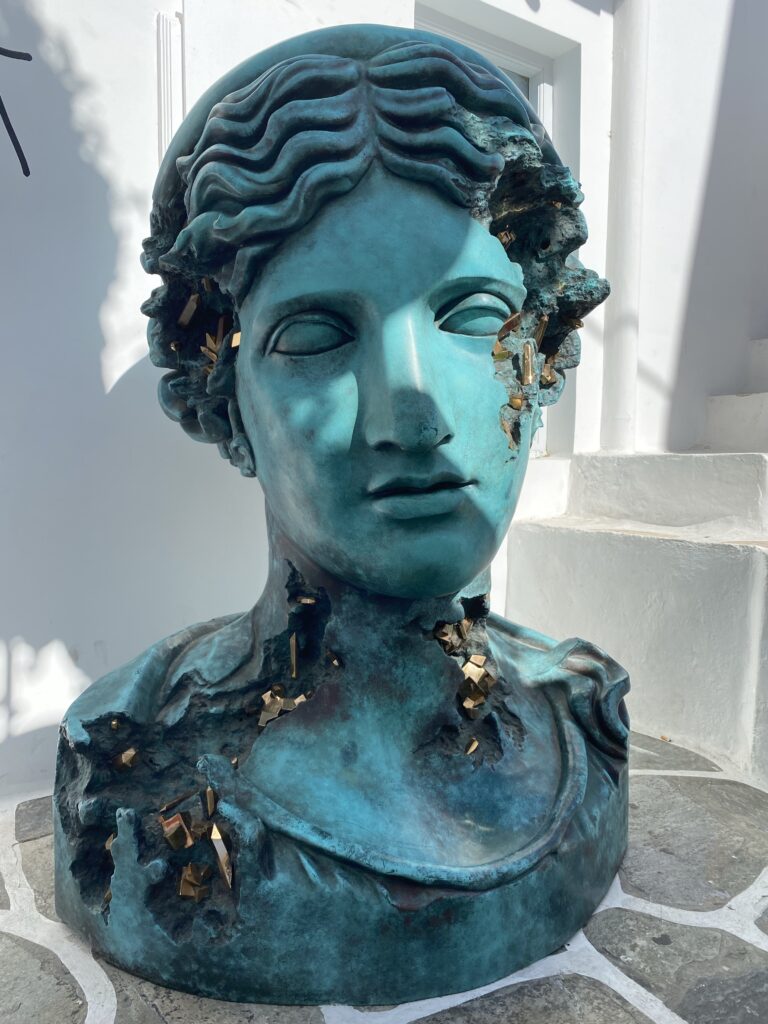
Our visit to Mykonos came at an interesting time of year. It was too cold for a beach day, and the tourist-focused town was in the process of shutting down for the season. The white-painted streets were mostly empty, and many stores had already closed. It allowed us to easily walk through the labyrinth, but without a goal beyond meandering. As we peeked around corners and into the small alleys and nooks, we were able to find some outstanding season-end shopping deals. The town was literally packing up for the winter, and many merchants were on their last couple days before shuttering. The more that was sold, the less to pack back to the mainland!
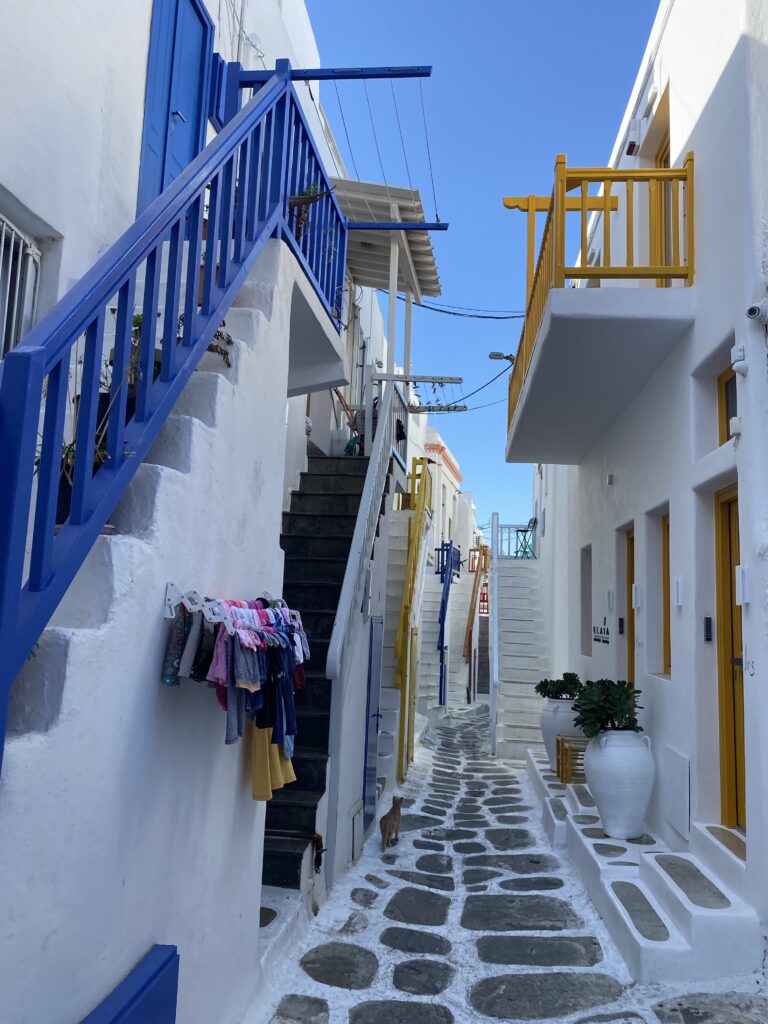
We also saw some of the notable sights, like the old windmills:
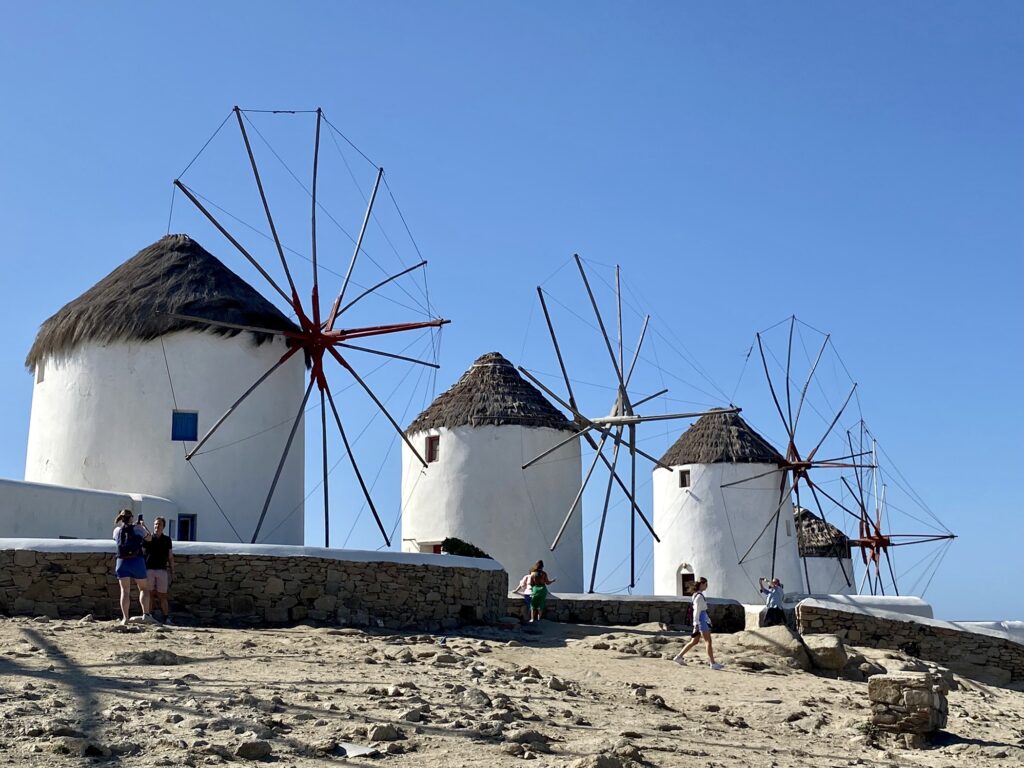
We walked through the Little Venice neighborhood, home to a number of restaurants and bars with arguably the best part of Mykonos: the incredible views! You can sit on the edge of a patio with the waves crashing below you, looking over the water at the windmills. But you will pay for this privilege: an Aperol Spritz cost over €20, more than twice what we paid in mainland Europe (and they were €4 in Bulgaria). We instead sat in the sun at the municipal beach and did some people-watching.
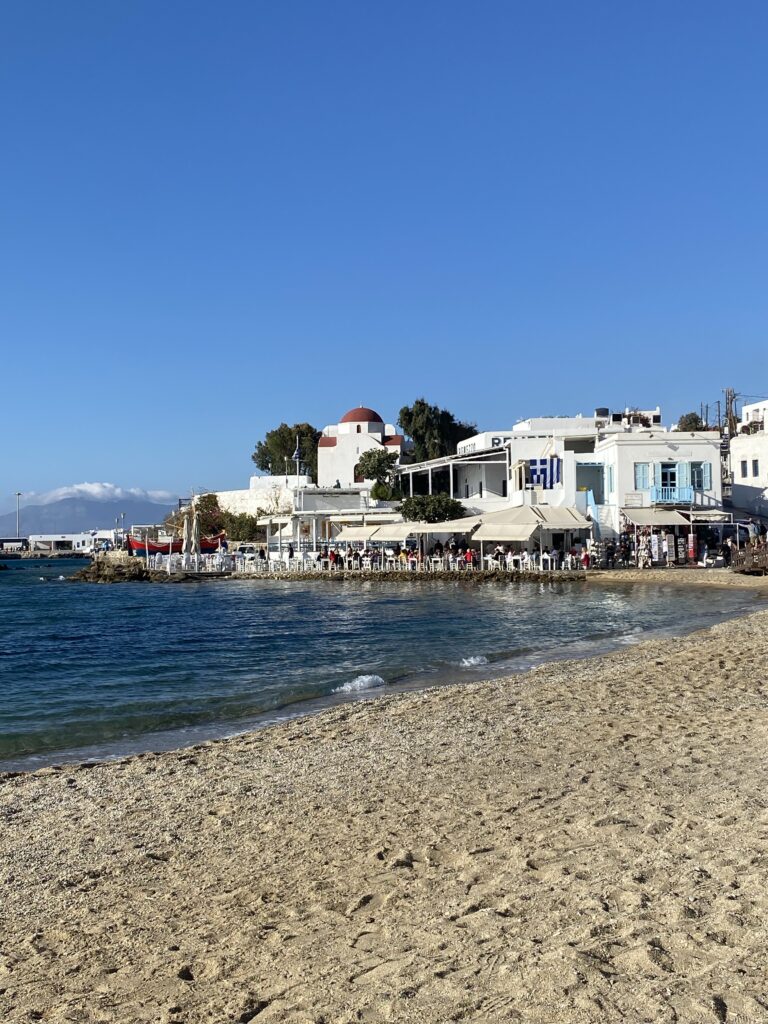
Touring Mykonos involves a bit of distance. We had no problems walking and enjoyed getting lost in the alleys and pathways. But while there is no bus shuttle from the cruise port, there is a reliable and reasonable “sea bus” available for just a couple of euros. We imagine that like most ferries, they provide a bit of budget-based scenic cruising if you pick the right seat.
We enjoyed the day and the beauty of the town, but certainly would not make a special trip to Mykonos. We believe there are other islands with similar charm at a lower price point.
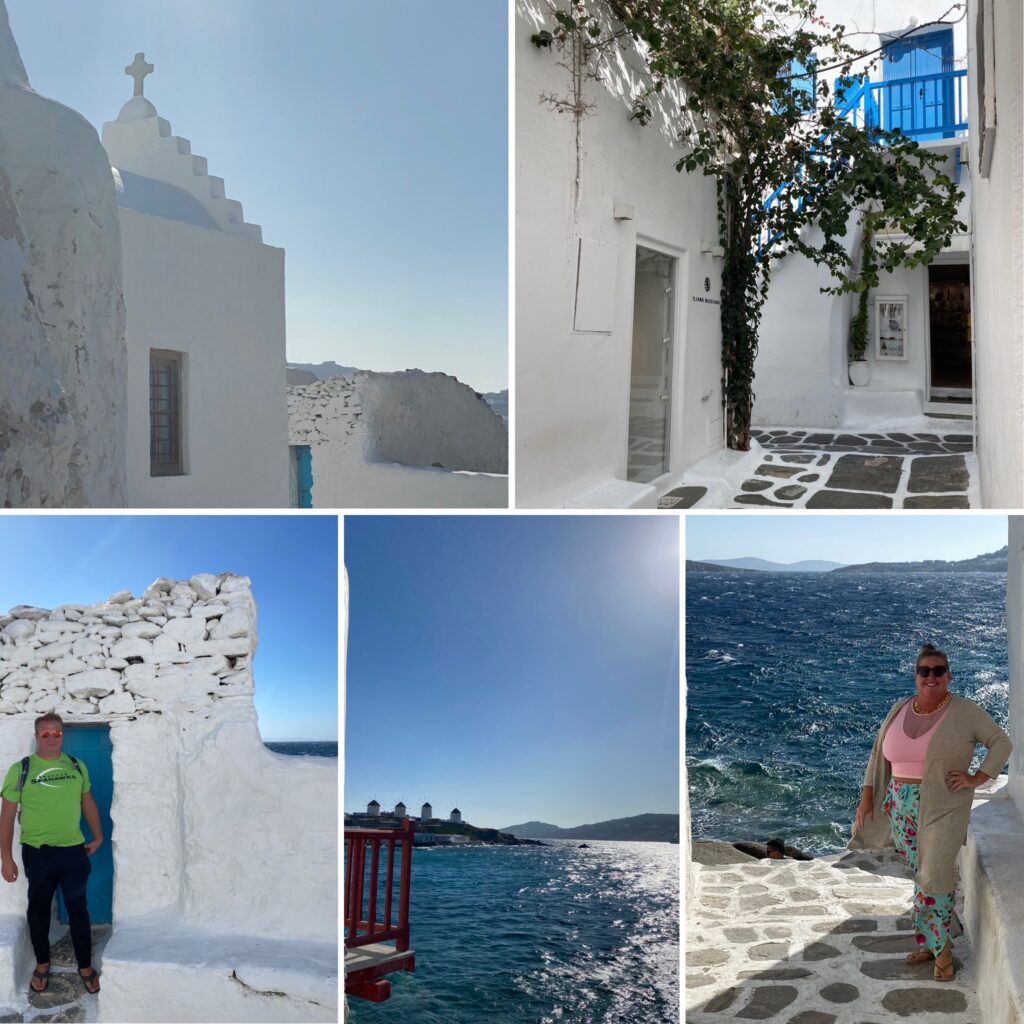
Ephesus (aka Efes, via Kusadasi), Turkey
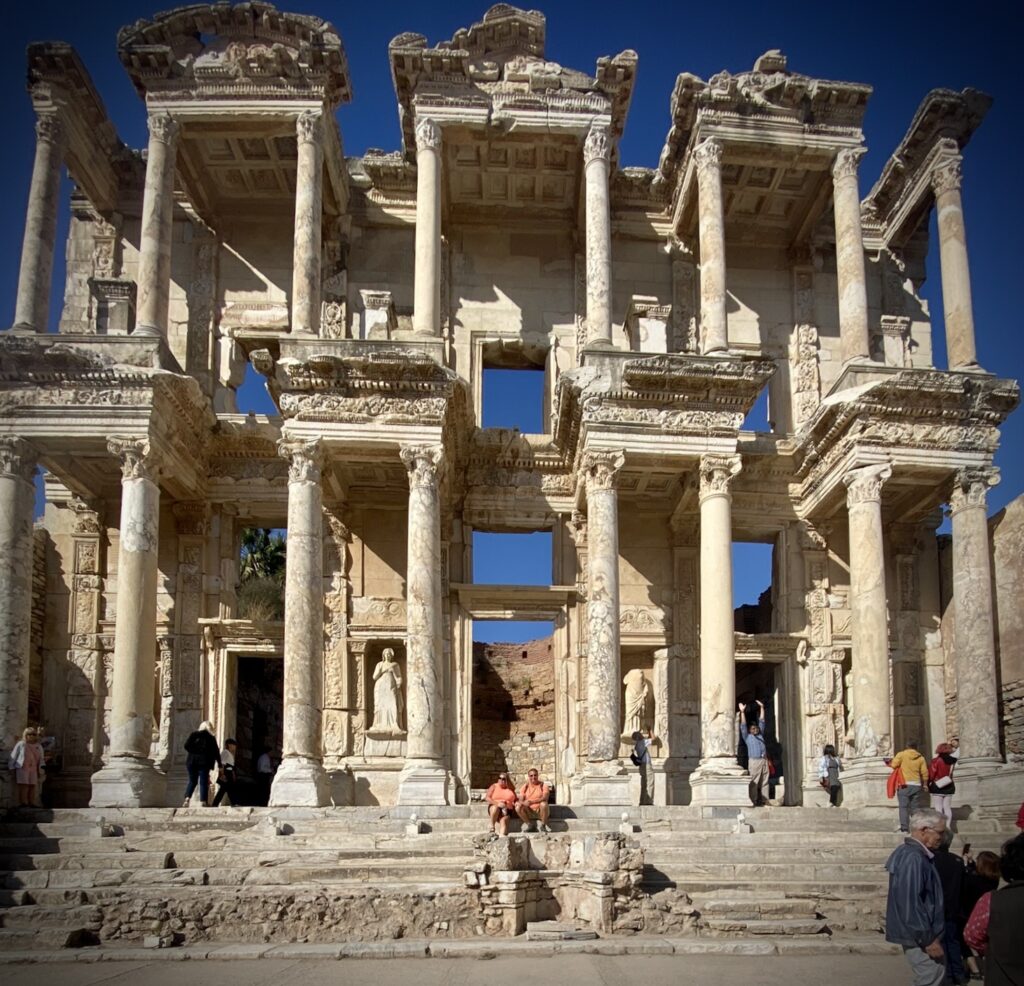
Kusadasi is a Turkish port city often used as the gateway to ancient Ephesus, located around 20 miles from the port. Fortunately we were able to meet up with Tammy’s old friend Jackie and her husband Hussein, who live in Kusadasi. They not only gave us a ride but helped us find multiple examples of Turkish food to eat, along with many cups of hot tea! Many thanks for showing us a great day, and we hope to come back later to explore more of Turkey!
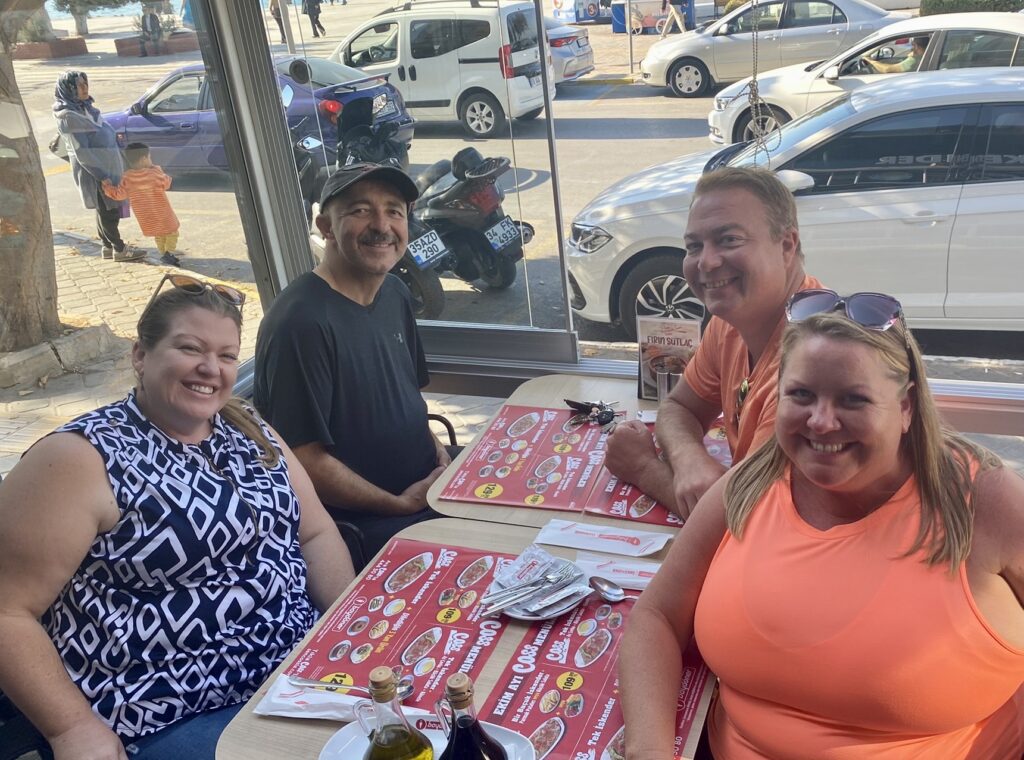
Historic Ephesus was an important Greek, Roman, and Byzantine town, that eventually declined due to the harbor filling up with silt (and other reasons). Today the coast is more than two miles away from the town site. The historical site has a number of important structures, including the façade of the Library of Celsus, reconstructed using the remaining fragments found on-site. It shows the history of an important city through multiple empires, and a site that has not been built over by a modern city.
One of the highlights for us was the combination brothel and public restroom. Along with the aqueduct and sewer system, it showed a little slice of everyday life in a Roman town, similar to the experience at Pompeii.
Toulon (via La Seyne-sur-Mer), France
This is a port we had been to before. Last time we took a quick walk across town to the train station and then took the train to Bandol where we drank wine and enjoyed the beach.
This trip had a shorter port time, so we decided to focus on Toulon itself. Once again we docked across the harbor in Seyne-sur-Mer. It looks like a short distance on the map but walking it would kill the entire day. The cruise line offered a water shuttle for $12 USD, which we thought was outlandishly expensive. Instead, we walked out of the port to the nearby Water Bus (Line 8M), which for €2 (per person, each direction) crosses the harbor, leaving about every 20 minutes.
It was interesting to see Toulon again, but now decorated for Christmas. We found there to be not much to do in the town other than eating at the Central Market. We had an outstanding meal of oysters and French wine.
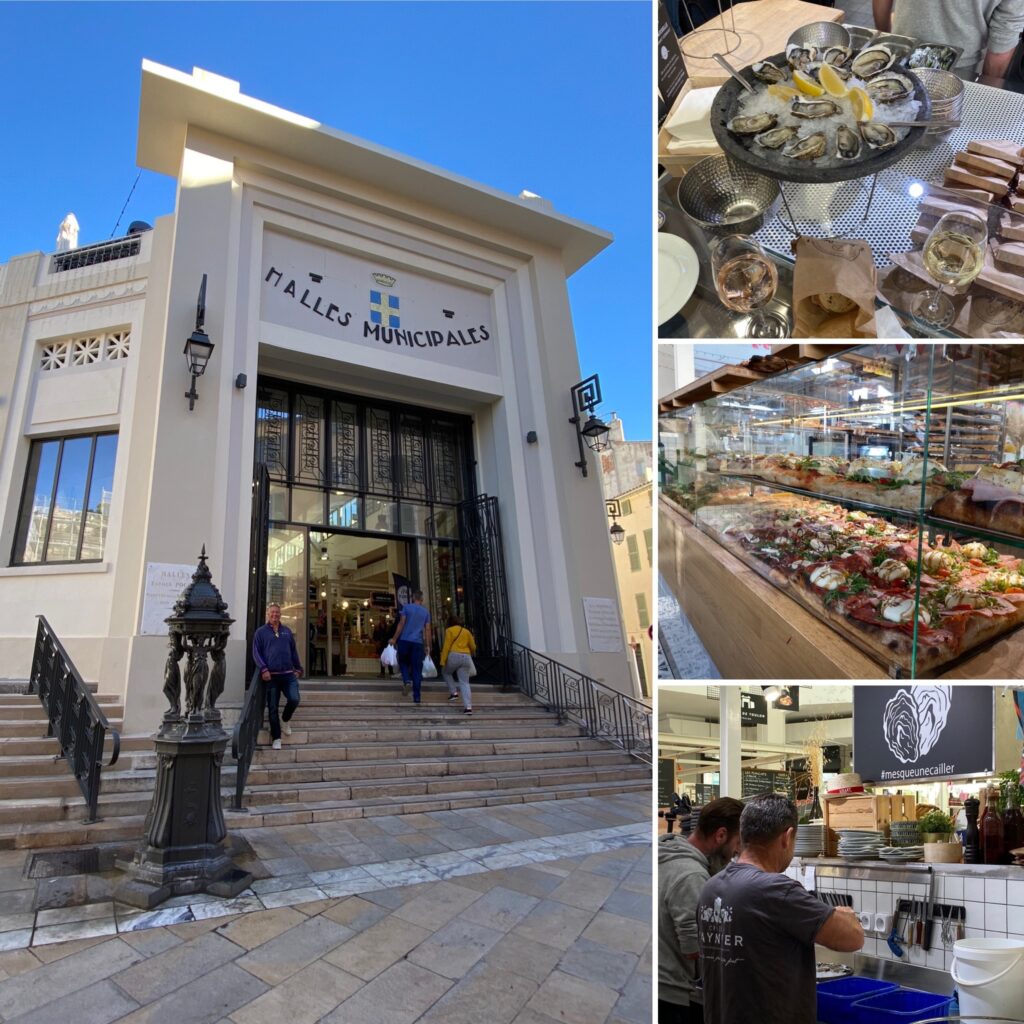
A lesson from this port stop is to take better notes on what sights we have seen. As we toured the town, we ended up covering a lot of the same ground that we had already seen on our previous walk through.
Next time we end up in Seyne-sur-Mer, we will likely make it a French Riviera day: instead of heading east to Toulon, we would take the bus west and either go to a beach or on a nice seawalk!
Marseille, France
We have read that depending on your style, you will either like Marseille or Aix. With two port stops in Marseille, we had the opportunity to tour both towns.
First, this port is a giant pain as a cruise stop. The Joliette cruise terminal is close to town, but large ships will stop in the Marseille Provence Cruise Terminal, which, well, is not. The port itself is around three miles long, and since it is a working industrial port, you start the morning far from anyplace you actually want to be. The ship offered a shuttle to town at a price we were not willing to pay. There is a free port shuttle but in our experience, there was not enough supply for the demand, resulting in lines and full busses, even before the 20+ minute ride. We tried walking out of the port and instead taking a local bus, but there are limited pedestrian exits, and then we were confused by the bus stops where the port exit meets the exits from the freeway. Were we to wait at the stop inside the port gate, at the freeway exit, or at the stop at the freeway overpass?
Without a long port day, it will be difficult to do much in Marseille.
We ended up walking through the old neighborhood of Le Panier. Our random walk did not yield much for sightseeing.
From there we went down to the Old Port (Vieux Port) area, which offered vast areas for people to congregate and watch the spectacular sunset.
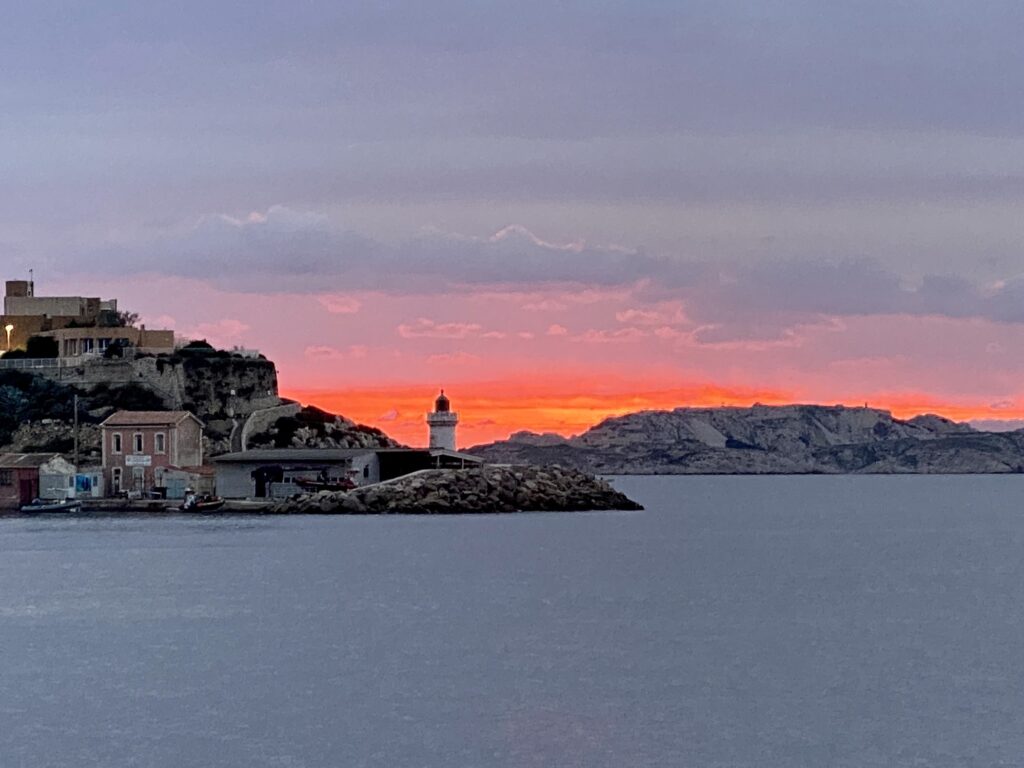
We saw old buildings like the Marseille Cathedral and new ones like the Mucem museum.
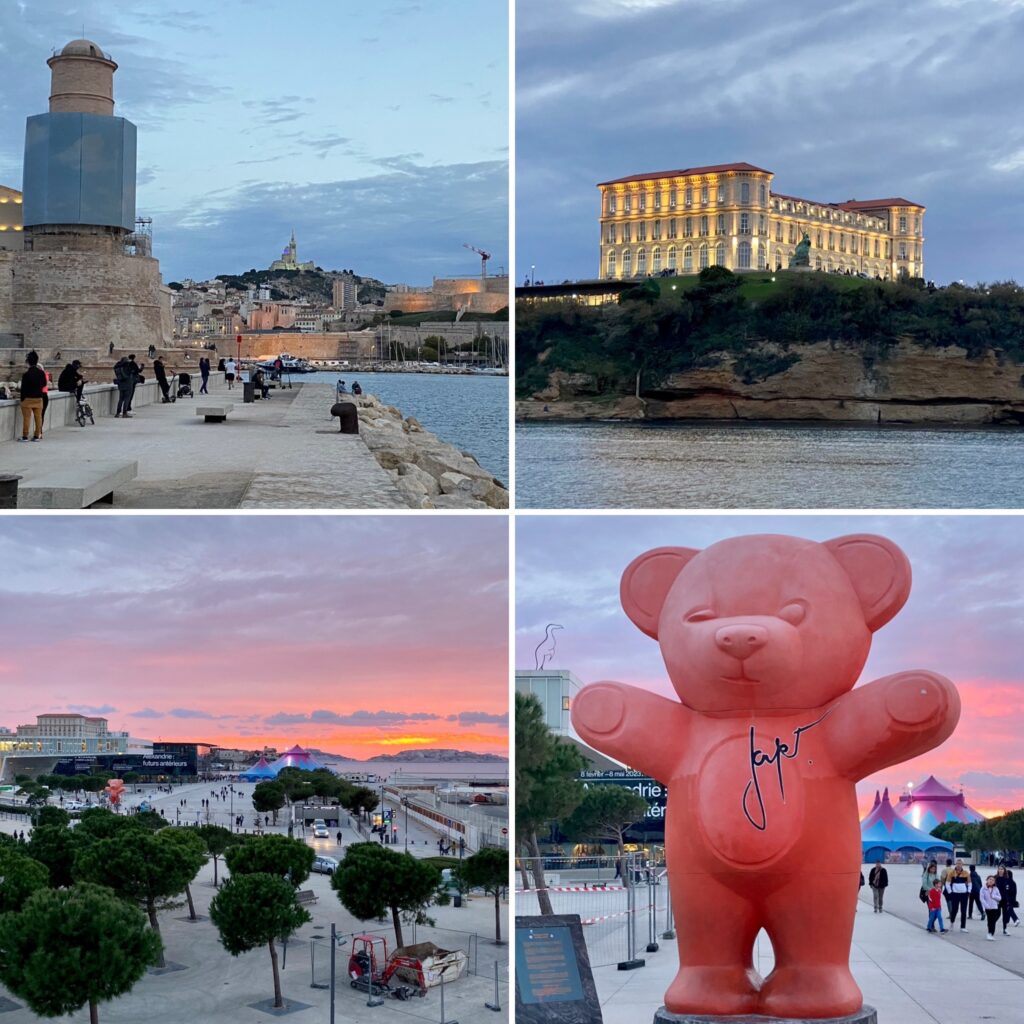
And since we were in France, we bought a baguette, which we toted around in comical fashion!
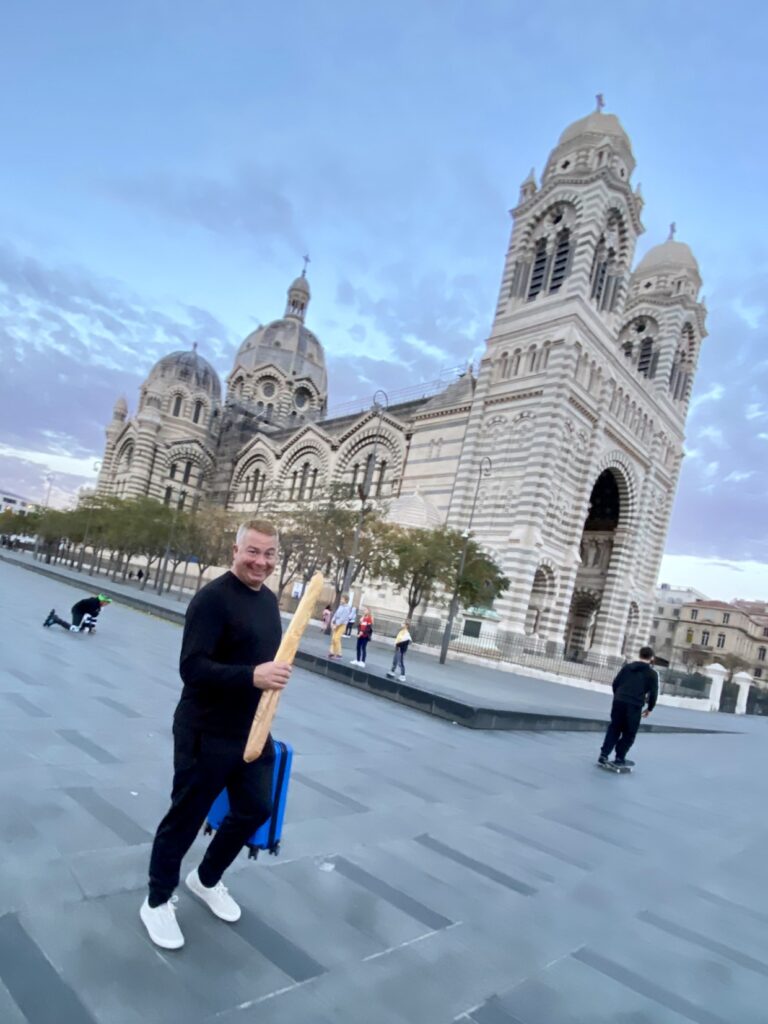
Next time we would have more destinations in mind, perhaps putting together a true walking tour. We also will recognize that it will take forever to get from the ship to anything we want to see. Our advice: Be patient and take the port shuttle. But watch the time, because it stopped running well before our on-board time. For our return, we ended up seeing a ship shuttle in town, so we just boarded it with confidence and hitched a ride back to the boat.
Aix-en-Provence (via Marseille), France
Spoiler: We preferred Aix!
From the cruise ship, we waited and took the Marseille port shuttle. From there we walked up the hill to the bus station (which is next to the train station). All told, it was nearly two hours from the time we left the ship before we started our walking tour of Aix. The Aix bus station is also a little bit outside of the town center, but the walk into town is very pleasant with quaint tree-lined streets.
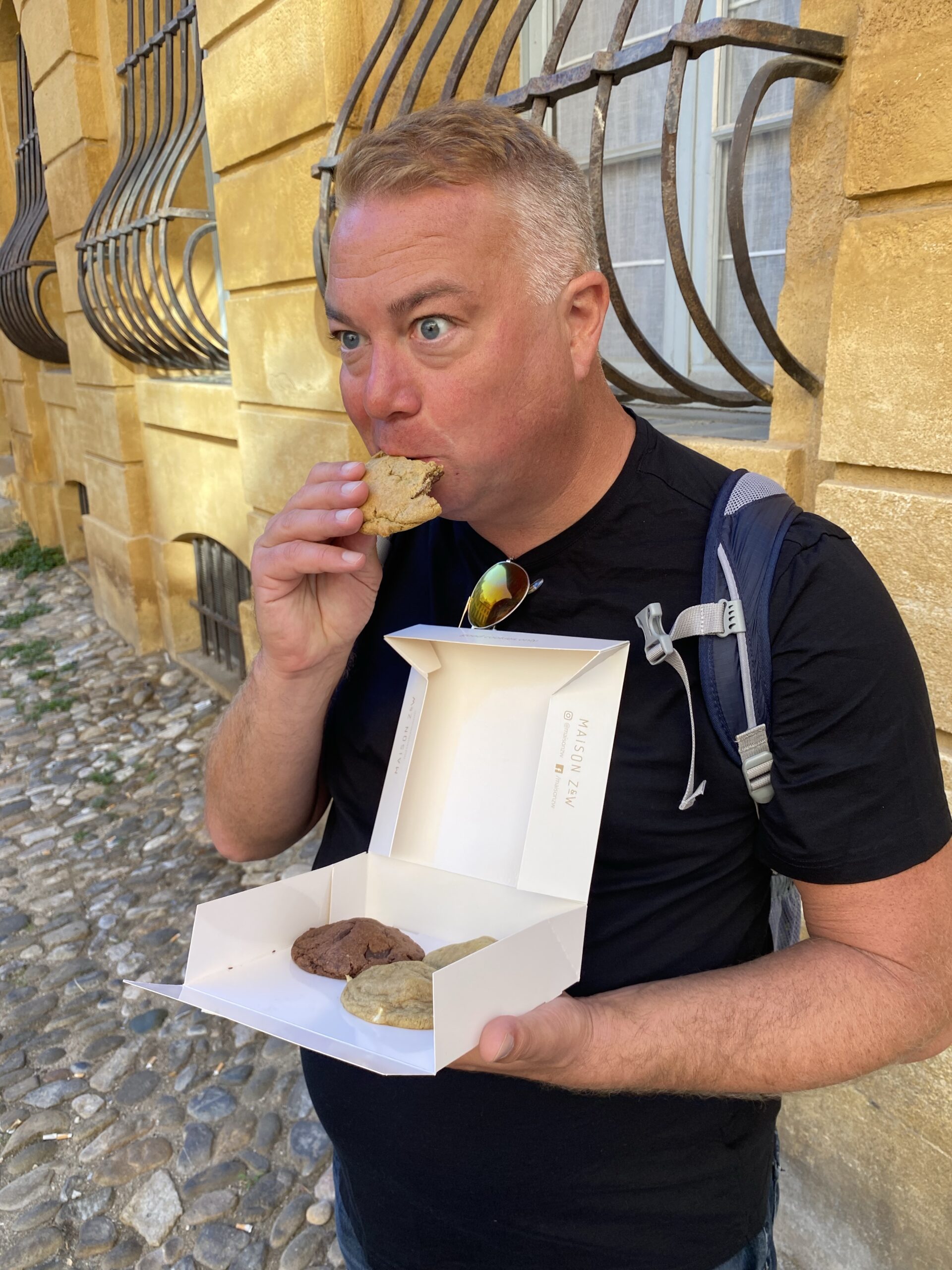
We spent the morning in and around Place Richelme, the town square which has a large outdoor market every morning. We stopped for some coffee and croissants and people watching. As we went through the market, we collected items for our later lunch: bread, cheeses, and cured meats.
Walking Aix is a real treat: there are fountains, statues, and lush plantings everywhere.
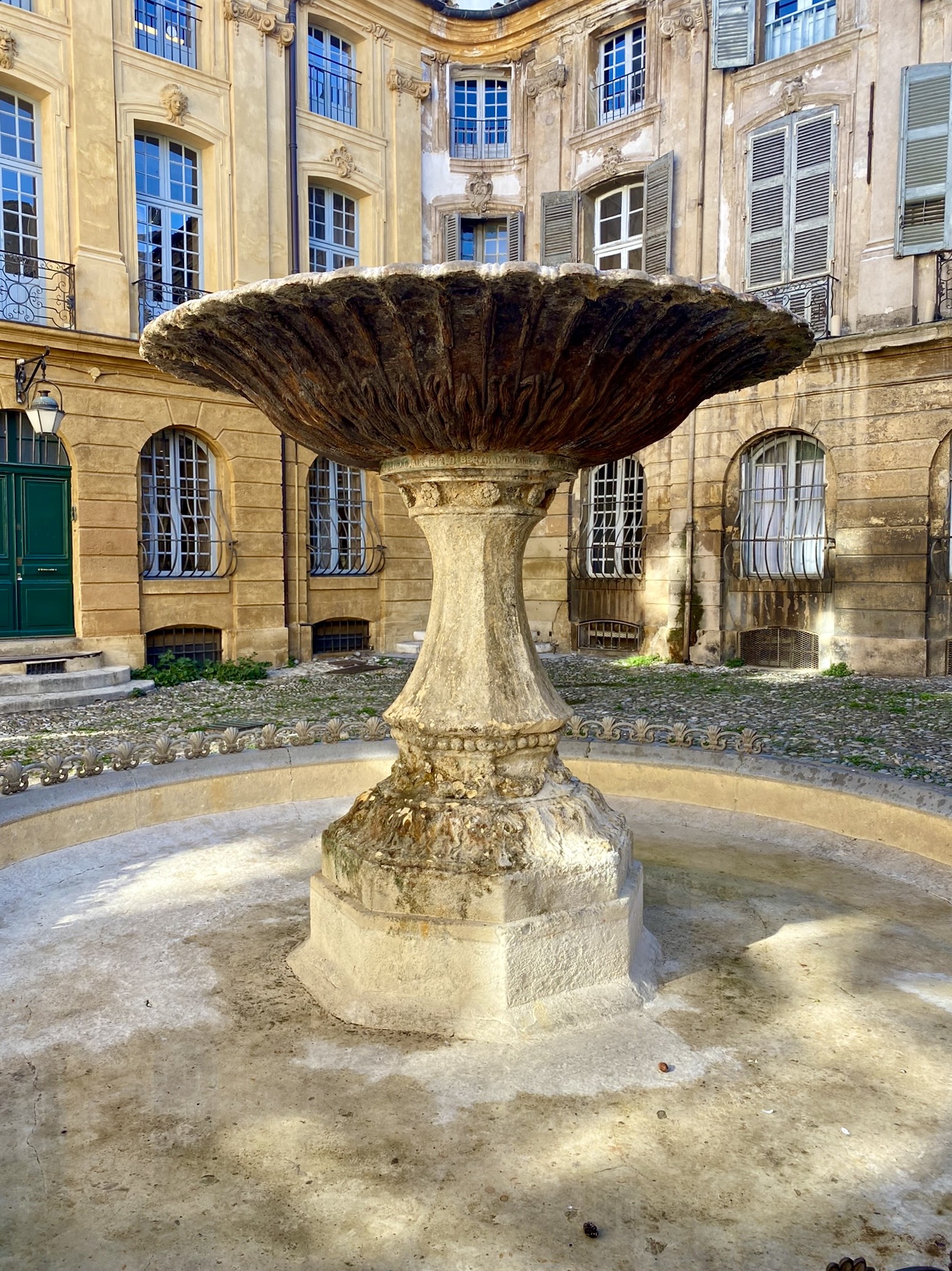
This is a college town and as we ate our picnic lunch, we were surrounded by dozens of fashionable French students in stylish back-to-school garb. While the town is certainly touristy, there are plenty of down-to-earth places for the college kids to eat and drink, and they seemed to perch on any staircase, planter box, or anything that resembled a bench.
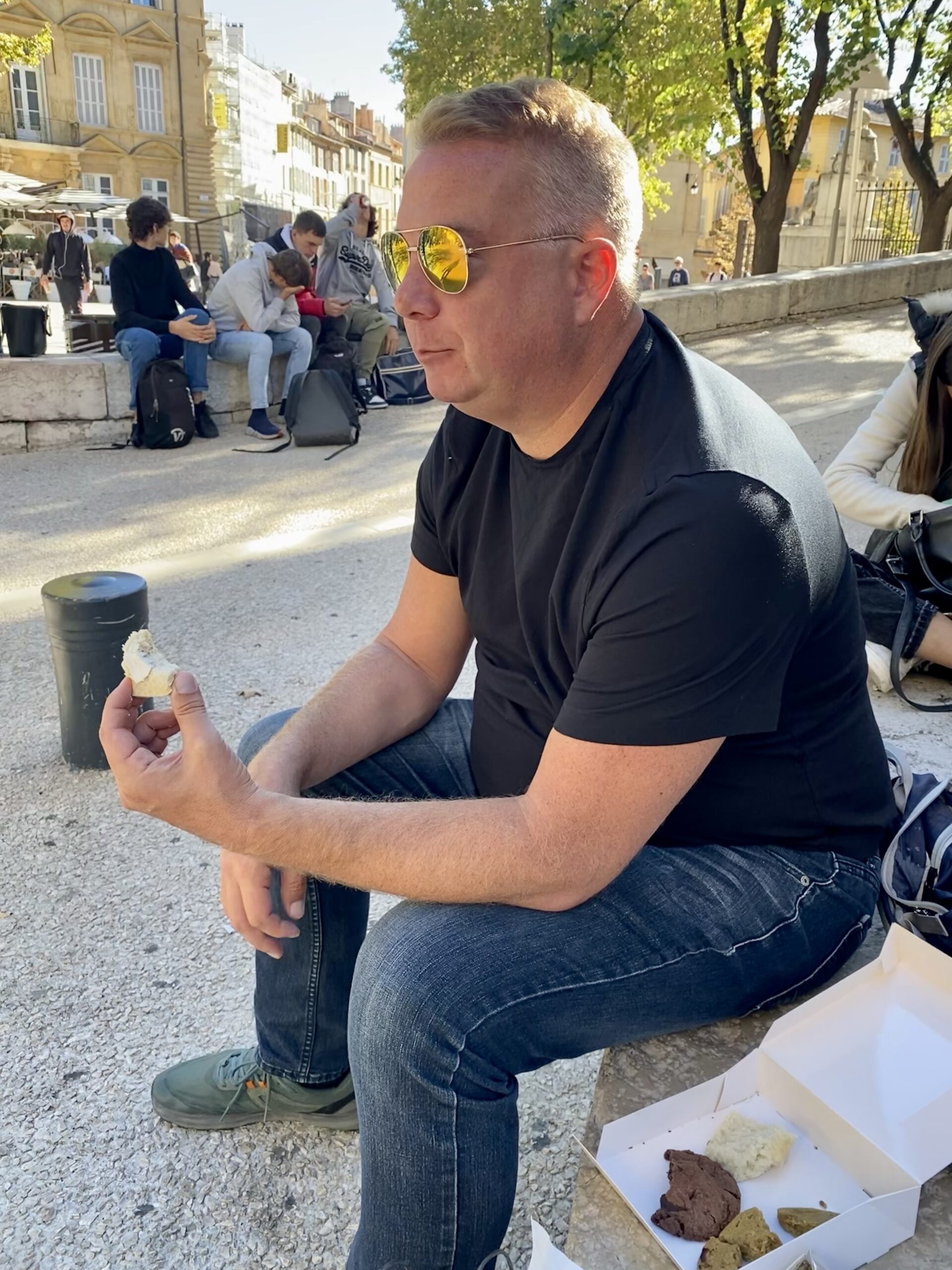
Most importantly, there were many places where we could enjoy the rose wine that Provence is known for. We enjoyed an afternoon wine in the garden at Hôtel de Caumont, a mansion built in the early 1700’s and well-restored, with a garden designed to be authentic to the time of construction.
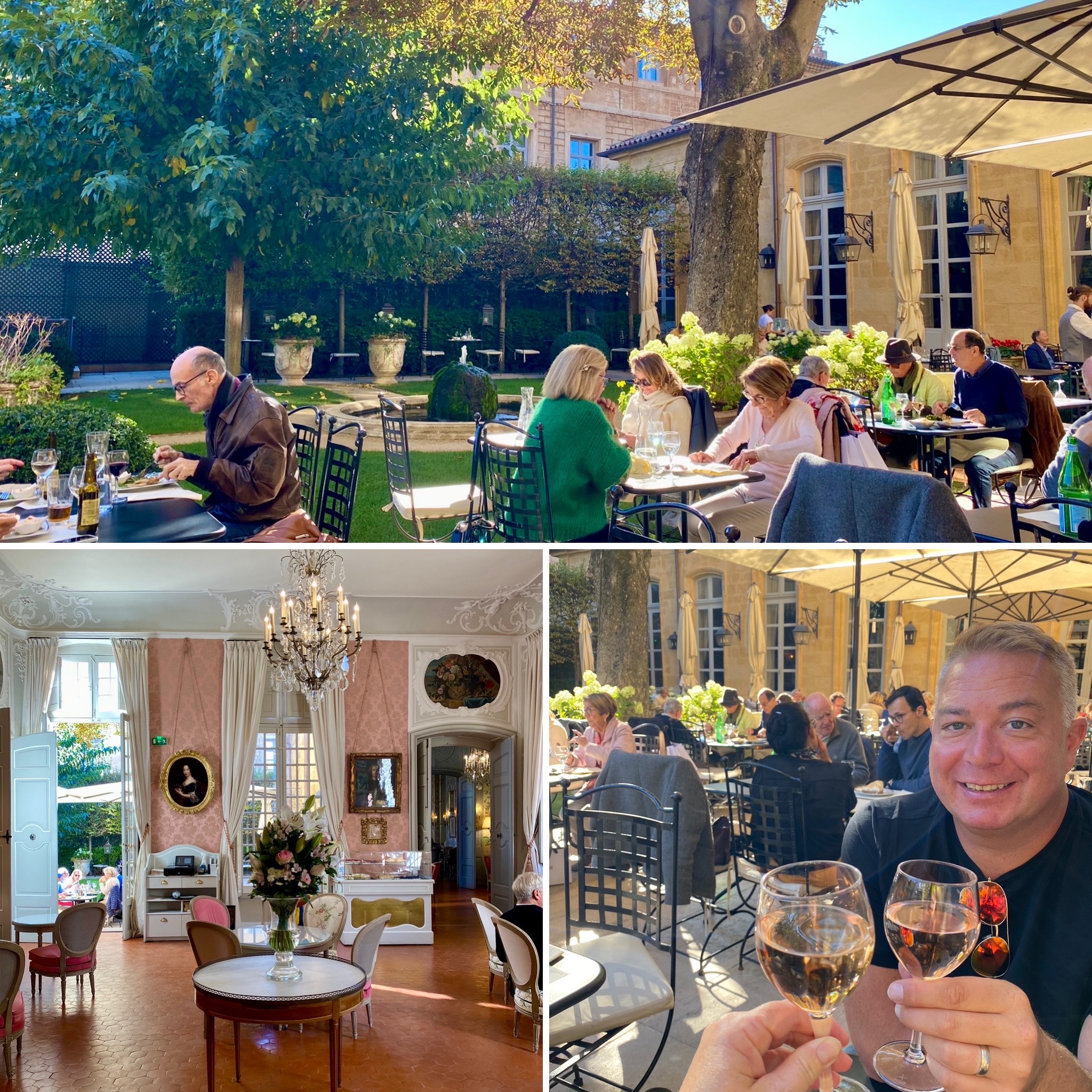
We had a fun day exploring Aix, and would spend more time around Provence in the future.
Valencia, Spain
Valencia was one of the first ports that we visited when we first started our sabbatical.
As far as larger cities go, this is one of Tammy’s favorites in Spain. There are lots of neighborhoods to enjoy, historic buildings, interesting architecture, and fantastic food.
This time, instead of walking all the way from the port, we took the bus. This saved a good deal of time, as the area close to the port is not that interesting (but does appear to be developing).
Our first stop was the the City of Arts and Sciences. We had previously walked through this complex of buildings but without stopping at any of them. Our destination was the CaixaForum museum. This complex is part of a larger park in a former riverbed, and the park area is a hub of activity. The museum is located in the striking L’Agora building, which was originally designed as an arena for a tennis tournament, but has been wholly reconfigured and reopened.
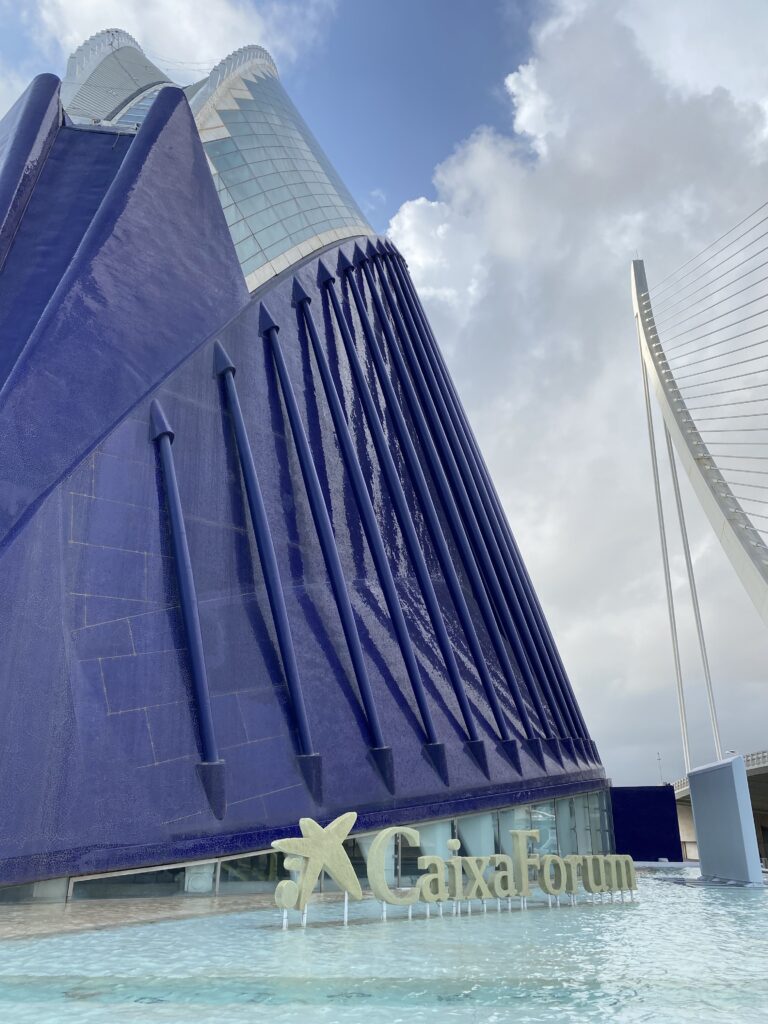
We spent some time looking at their art and the touring Egyptian exhibition and then continued onward.
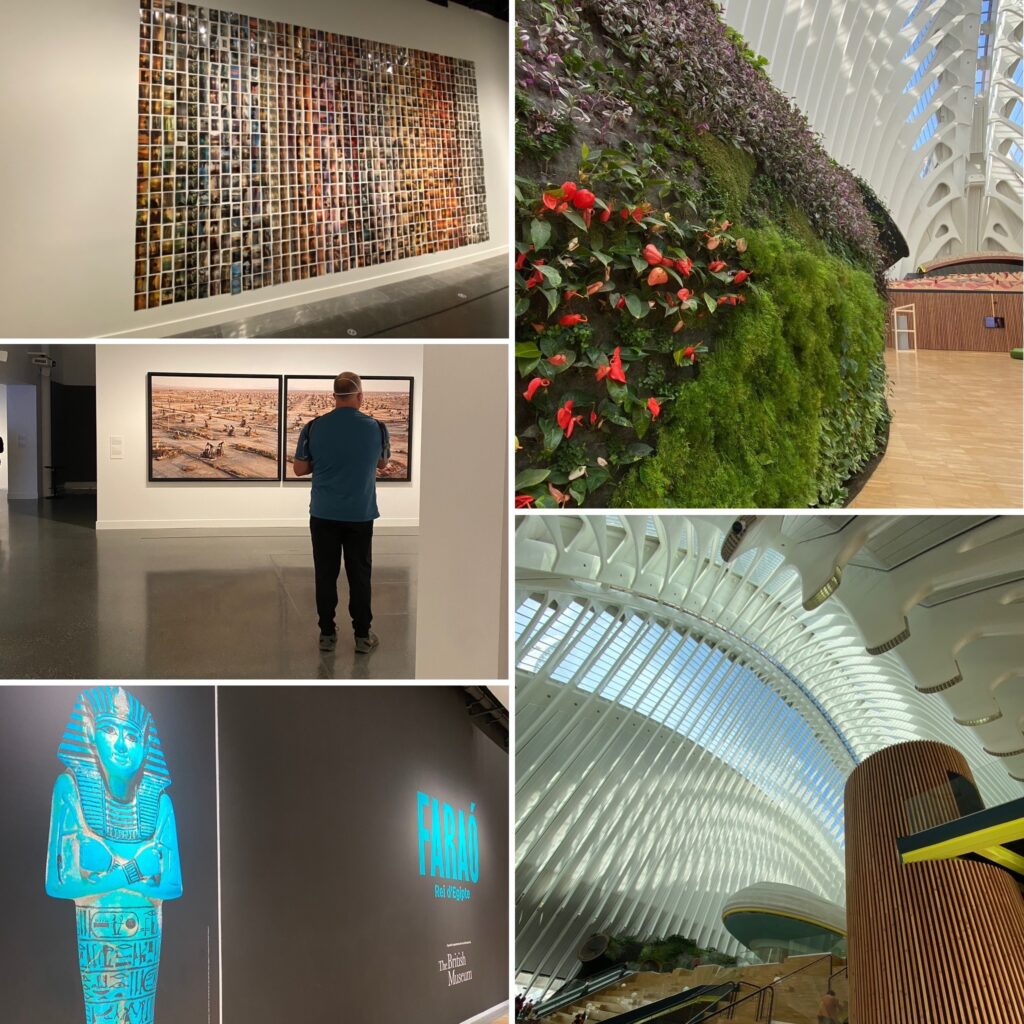
One of the highlights of our first visit was the Central Market and the surrounding areas. We went again to the market and had lunch outside. It was hard to choose from all the vibrant options!
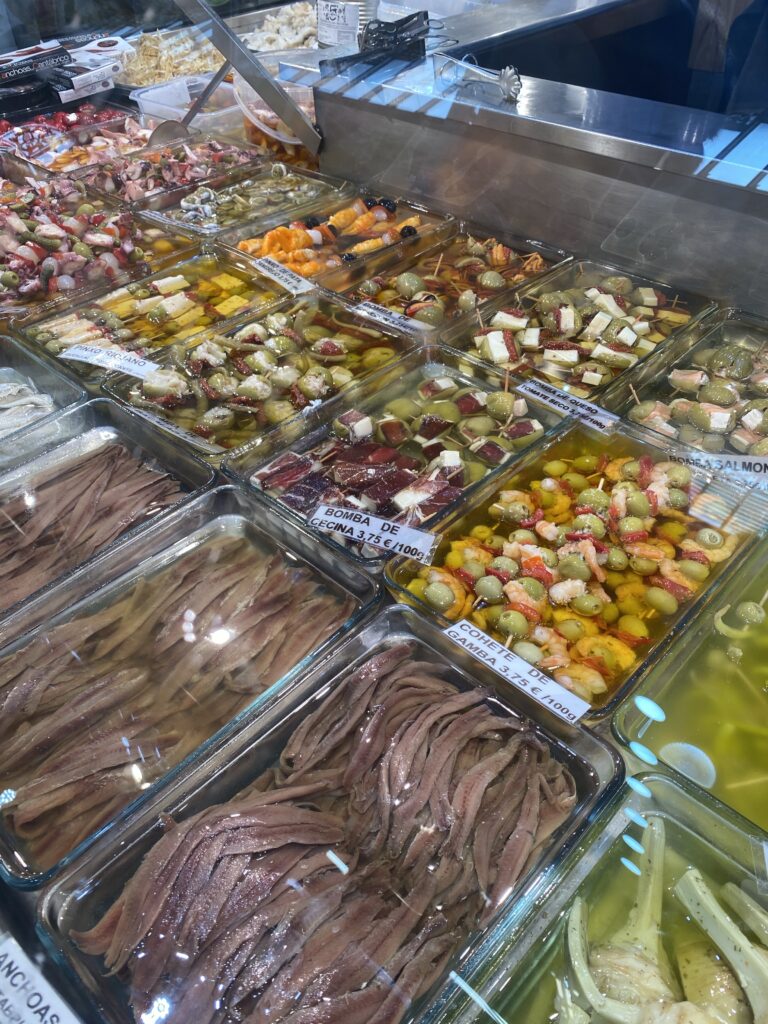
Then we spent the afternoon wandering around in the Spanish streets until we boarded a bus to get back to the ship.
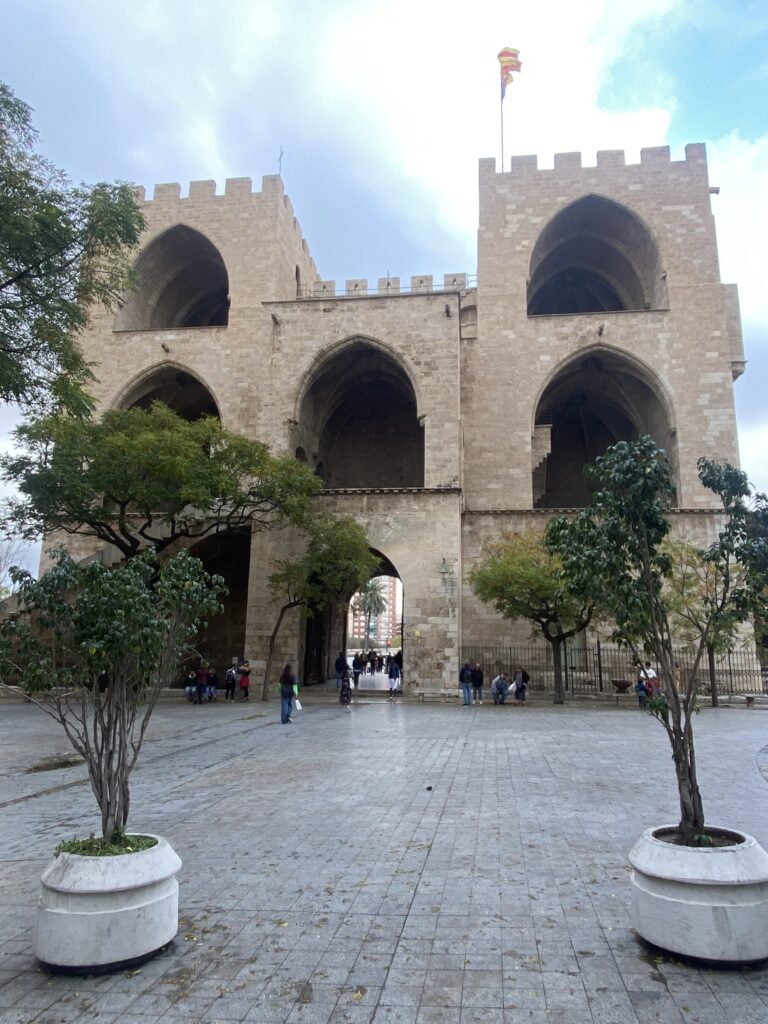
It was a relaxed day of exploration, and it felt good to be in Spain, a country that we both really enjoy!
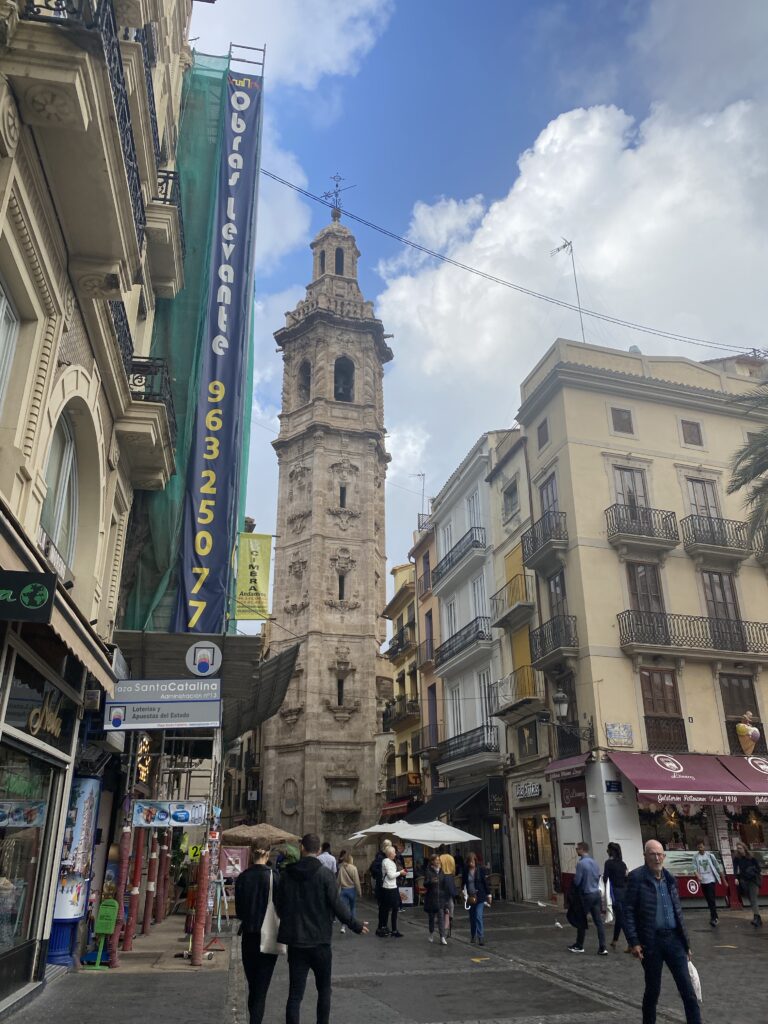
Palma de Mallorca, Mallorca, Spain
Sometimes a day just doesn’t go as planned. The walk from Palma to the center of town is quite long. It is scenic if you enjoy boats in marinas, but it is not a notably pleasant walk. The dining establishments here are designed for those coming off yachts: expensive and faceless.
Instead of making that walk again, we took a bus to Magaluf Beach. We had read that this was a long stretch of sand with plenty of activities. The sand was still there, but there were no activities to be found in late November. The weather was cold and windy, and virtually everything was shuttered for the season. The beach was pretty, and sweater-clad locals and their dogs were enjoying the seclusion.
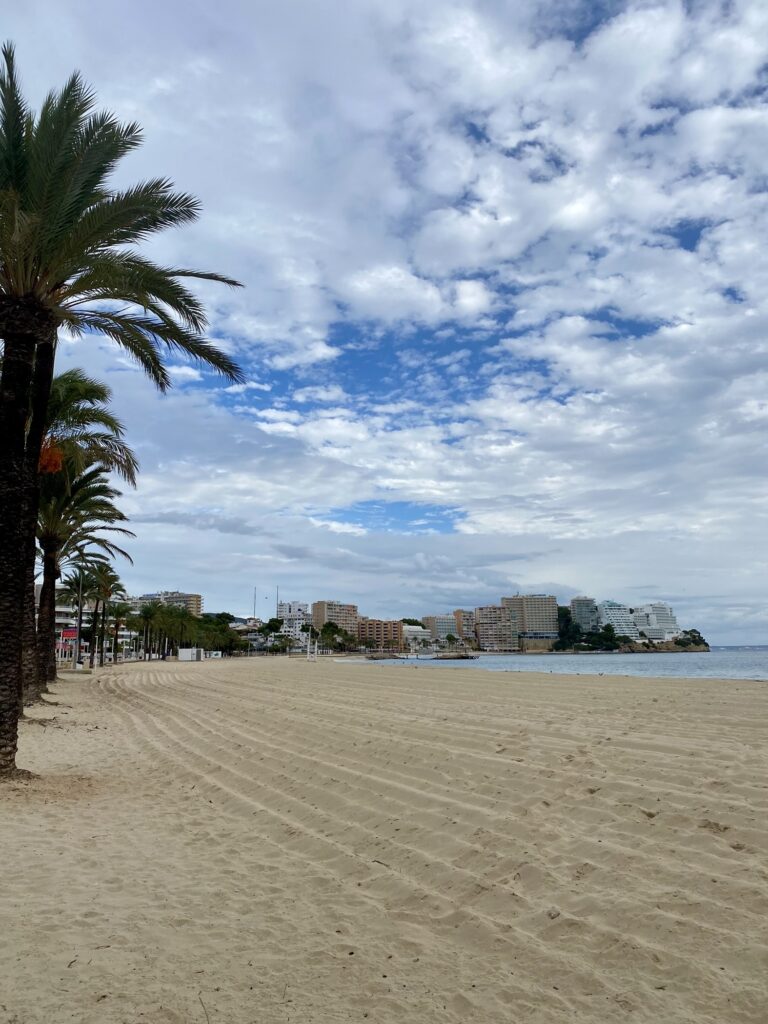
Even in season, we are not sure if we would want to come here. For a Spanish city, most of the establishments seemed to be catering to British tastes: English-language menus showing bean-and-tomato breakfast plates. Maybe it’s fun? But it did not seem like Spain to us.
We bussed back to the town center (which is more Spanish), walked around a while, then took a taxi back to the ship. Even by car, it is a bit of a maze to get into the cruise port!
Conclusion
One of the most important elements of a cruise port is getting from the ship to the sights. The easier this is, the better the day is!
It is fun to keep visiting various cities and exploring, but it gets overwhelming to have such a burst of activity. Each day we had to remember which language to speak, and often which currency to use.
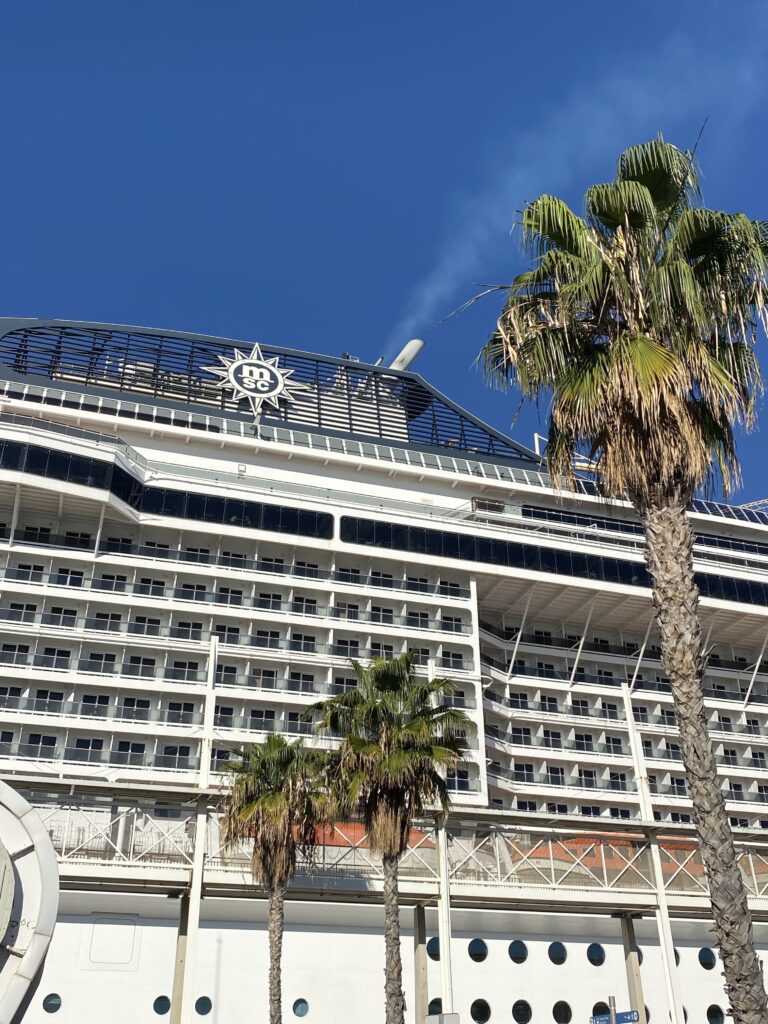
Our schedule relies on the ship’s schedule. This does not always jibe with when anything is open! Sometimes the boat arrives earlier than than even the coffee shop openings, sometimes the boat comes in on Sundays or holidays and there is nothing to see, and sometimes the boat stops in seasonal tourist ports, but outside of the tourist season! Even late departure times often mean skipping a nice dinner onshore so that we do not miss the ship.
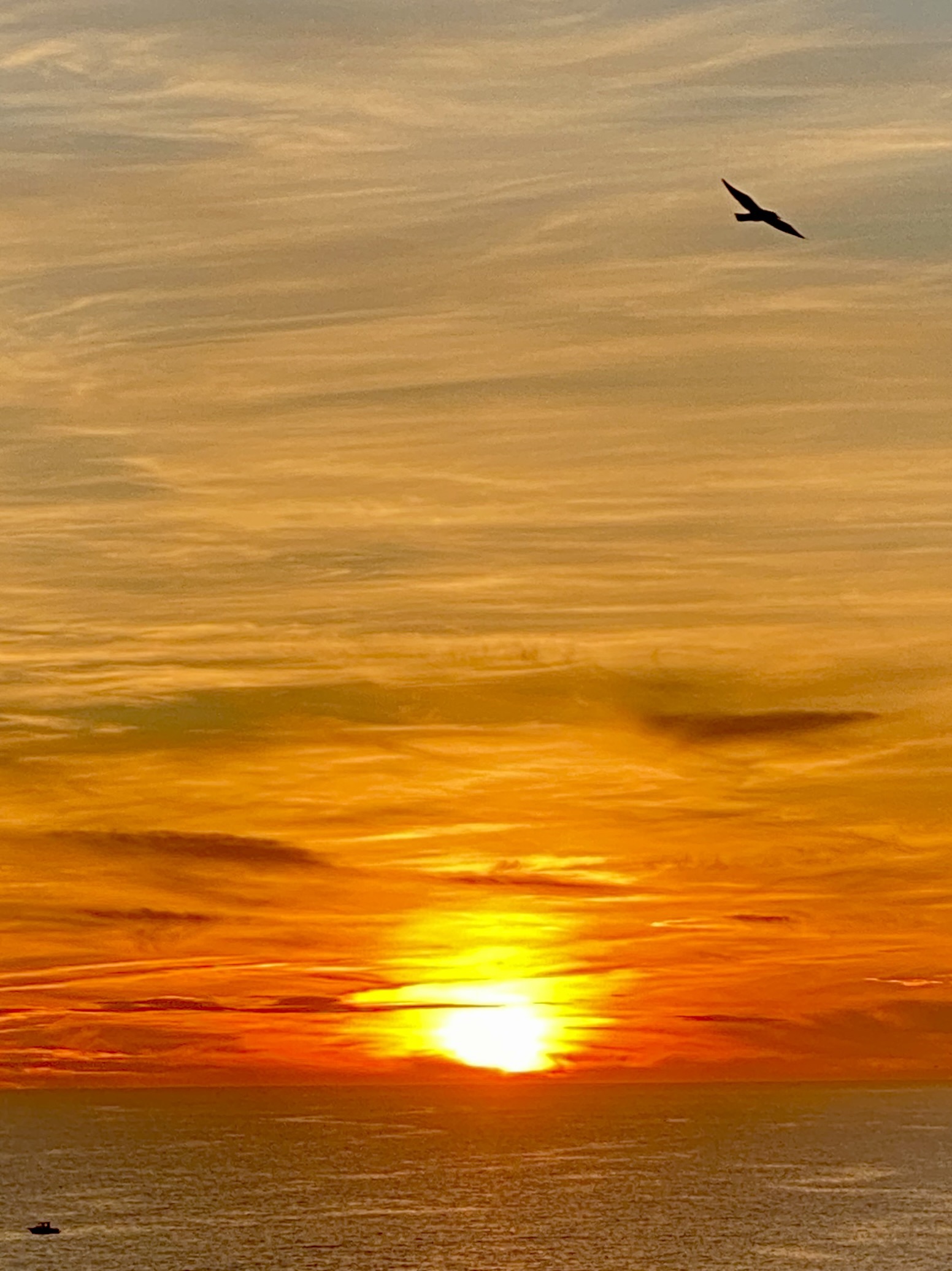
But with all the differences, a Mediterranean cruise is fun and enriching precisely because of the commonality of the maritime cultures: the harbors, beaches, cliff walks, and ships. Using a cruise ship to float around to the various port cities is a way to get the Mediterranean experience from the sea side.
If you missed it: Click here to read our review of the two ships, and click here to read about the Italian ports.
